Guiding actions and amenities onto the Victorian Volcanic Plains that use the Acacia Melanoxylon to curate walking trails.





 Emma Croker | Underworlds | Tutor: Bridget Keane
join the other worlds brigade!
Emma Croker | Underworlds | Tutor: Bridget Keane
join the other worlds brigade!

Guiding actions and amenities onto the Victorian Volcanic Plains that use the Acacia Melanoxylon to curate walking trails.





 Emma Croker | Underworlds | Tutor: Bridget Keane
join the other worlds brigade!
Emma Croker | Underworlds | Tutor: Bridget Keane
join the other worlds brigade!


AcaciaMelanoxylonResearchHarmanValley



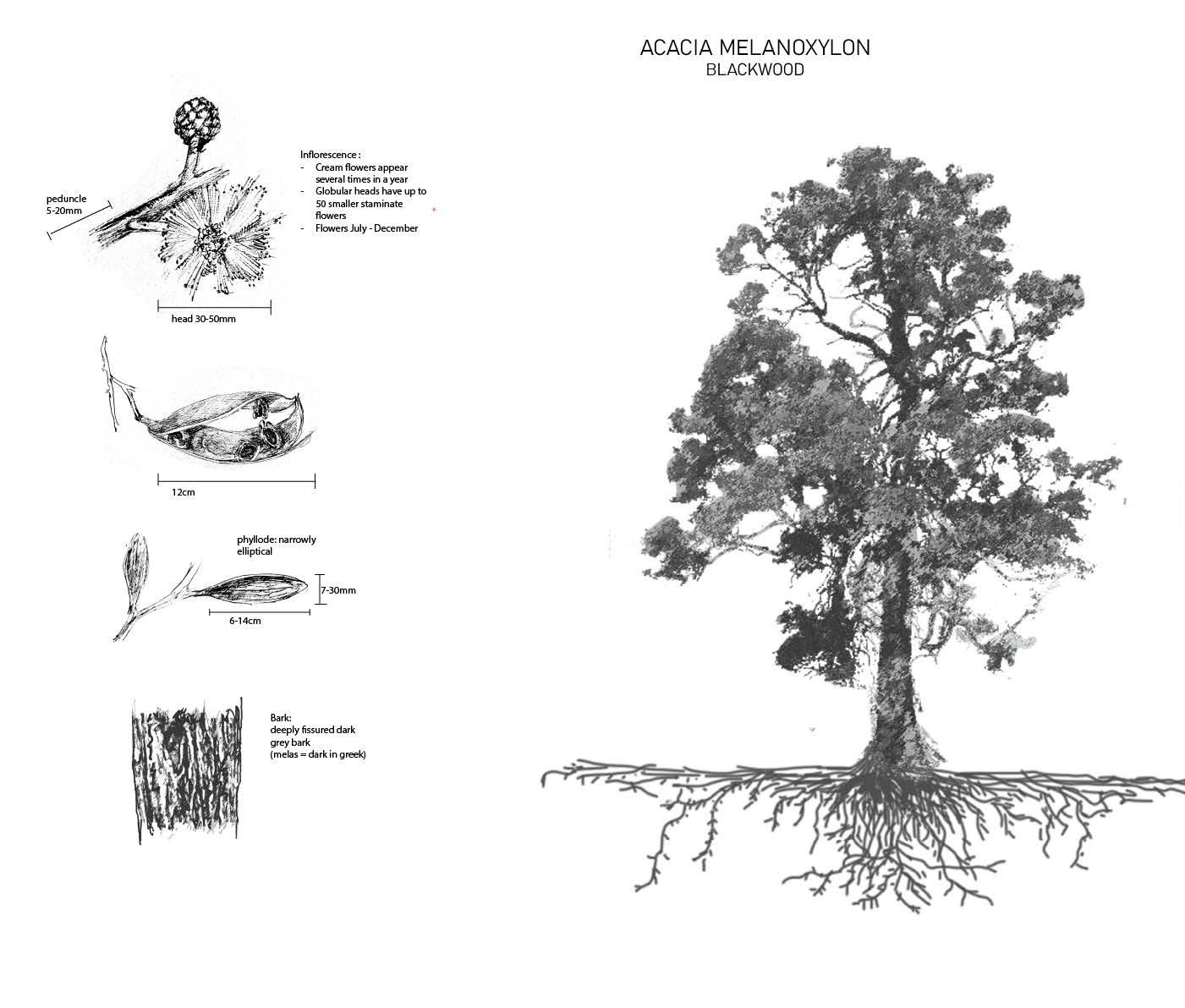
KanawinkaBioregionVolcanicTrail Masterplan



I would like to acknowledge the Woiwurrung people of the land on which I live and pay my respects to their elders past and present. I would also like to acknowledge the Gunditjmara people on whose lands I am designing this project.
I was born on Worimi and Awabakil land in NSW, and I am a non-Indigenous student with colonial heritage.
I expected to learn about the geological processes of Victoria in this studio ‘Underworlds’ with Bridget Keane. What I didn’t expect to learn is that minuscule, action-based design can have the most significant impact on a site.
The most interesting part of this project is designing and planning through the minuscule and understanding its reaction and impact over a much longer time frame.
I address the defunct larger Kanawinka Geopark in my XL mappings. Where the existing land management practices don’t work cohesively to fit the whole Geopark, I propose an action management system that would work across the whole park. I would like to further explore how the policies of Victoria and South Australia could work together to form a change in land management practices across the whole region. In my management plan, I outline the involvement Gunditjmara people.

The project looks back through deep time to look into the geological layers that lie under the site and how these layers can be brought forth to the surface through vegetation methods and other design actions. I create new narratives with the geology, especially basalt. I use the basalt geological layer to lay the foundations of the A. Melanoxylon. A narrative of rejuvenated Volcanic Plains by a series of actions plays out in the following field guide. I originally came to this project from the perspective
and narrative of an avid hiker, looking to find fault in the Victorian Volcanic Plains Trails. After the development of this project, I see no fault in the current Victorian Volcanic Plains Trails as the sites themselves are magnificent. Thus the project formed on the need for an extension to the trail to include more sites and the need for more people to know about them and to visit them.
I consider myself a guide and a curator in this studio, acting as an agent that brings people together to perform minute actions to have a larger effect; rather than the explicit design of physical amenities. The design inquiry first works its way through the historical geology of the sites revealed in sections and mappings, then reveals the larger system of the walking trails. The narrative follows a series of worlds that forms at each of the sites - becoming a conglomerate of worlds within worlds.
I design with a range of cartographic representations that include a series of mappings that map the inverse of the standard map, and then map the reveal of that. I also explore new techniques of visualising 3D places with diagramming, sections and perspective mapping.




 Byaduk Caves
Byaduk Caves
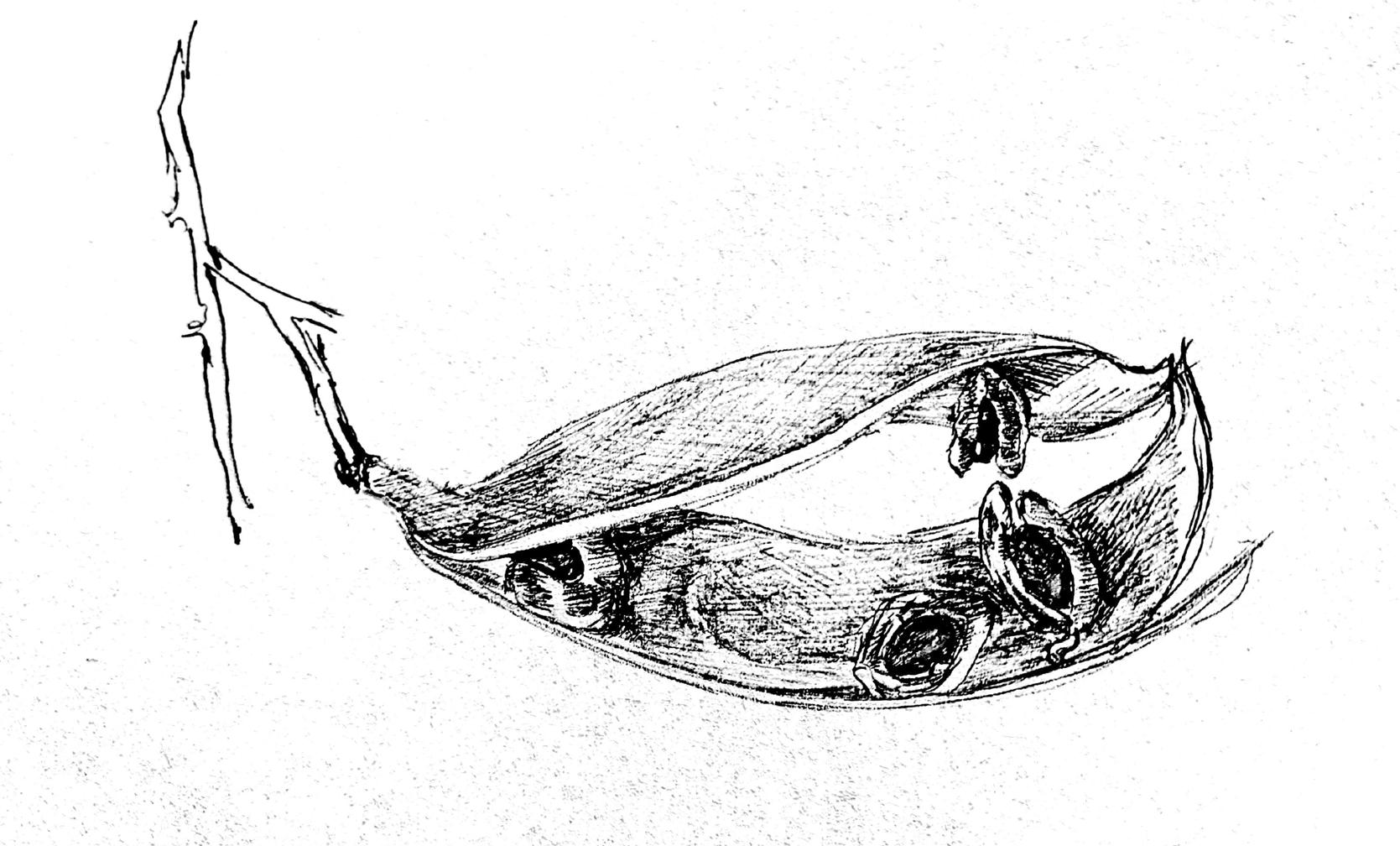
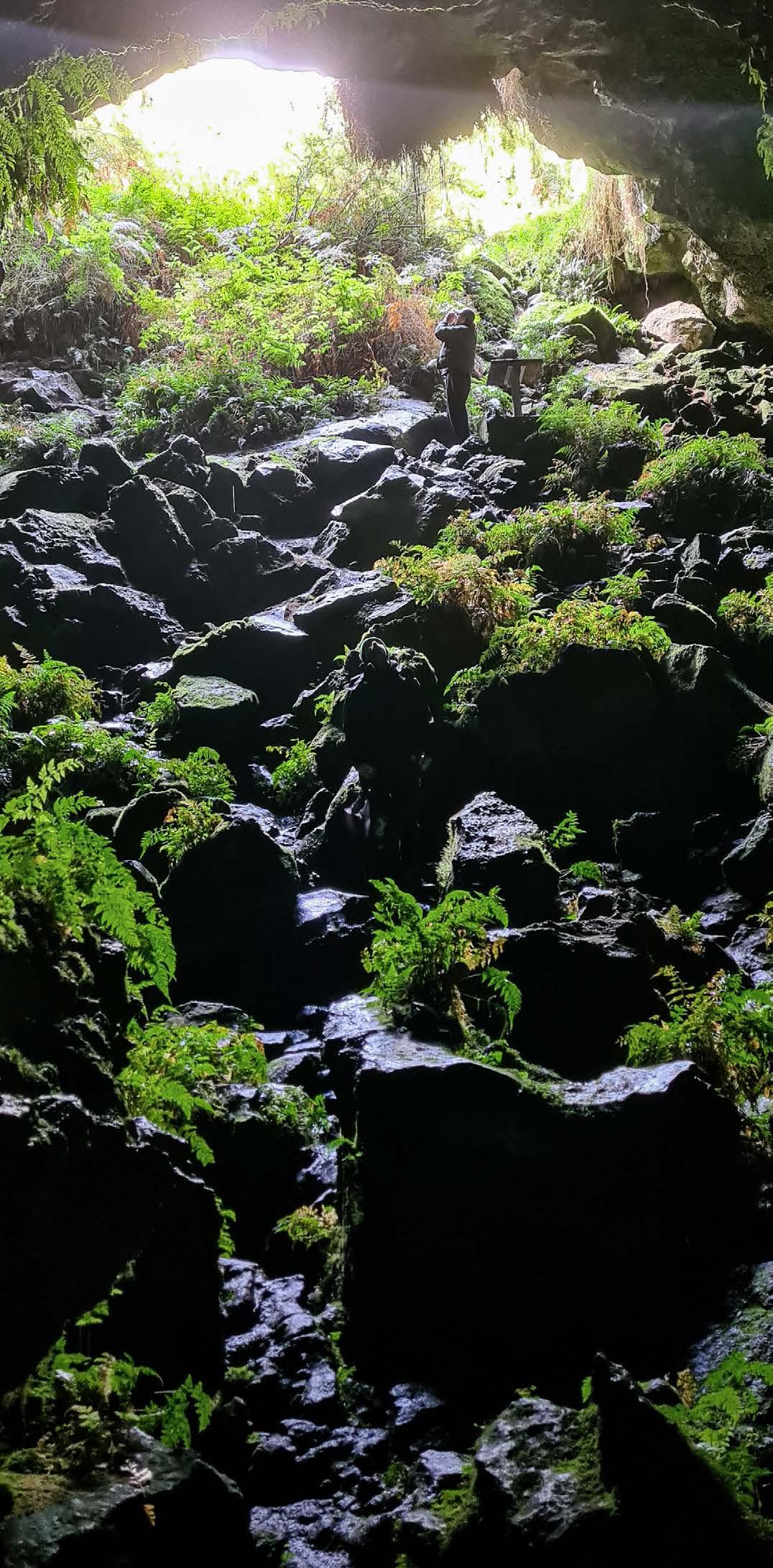
Site visit to Wannon Falls, Nigretta Falls, Byaduk Caves, Harman Valley Lookout and Mt Napier.





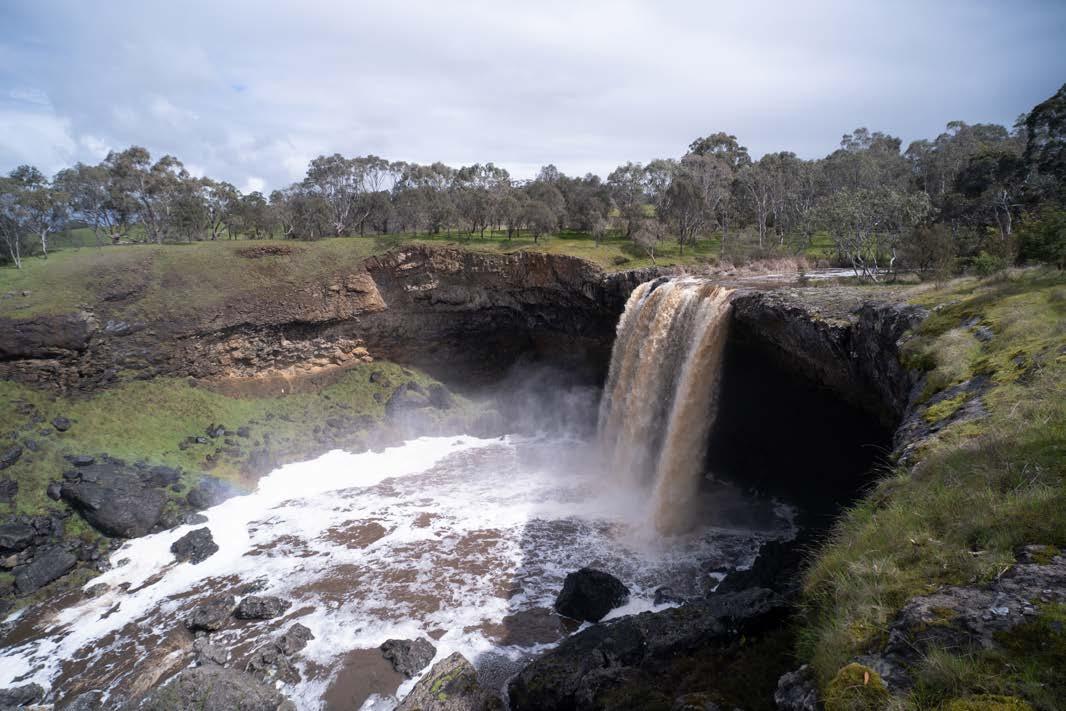
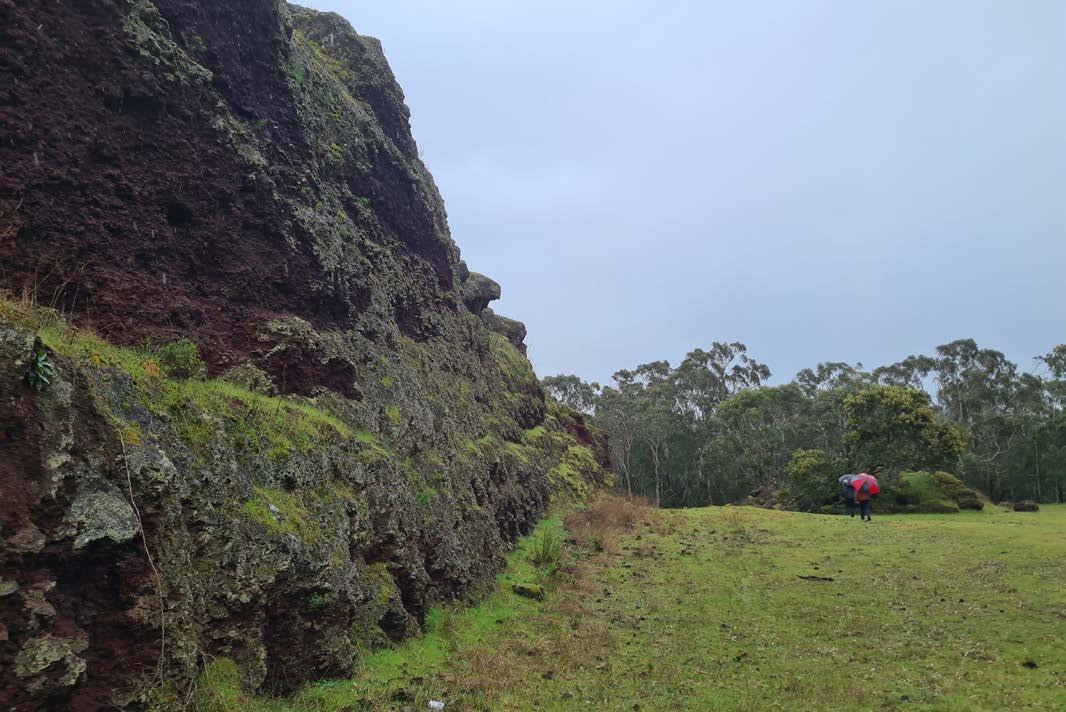


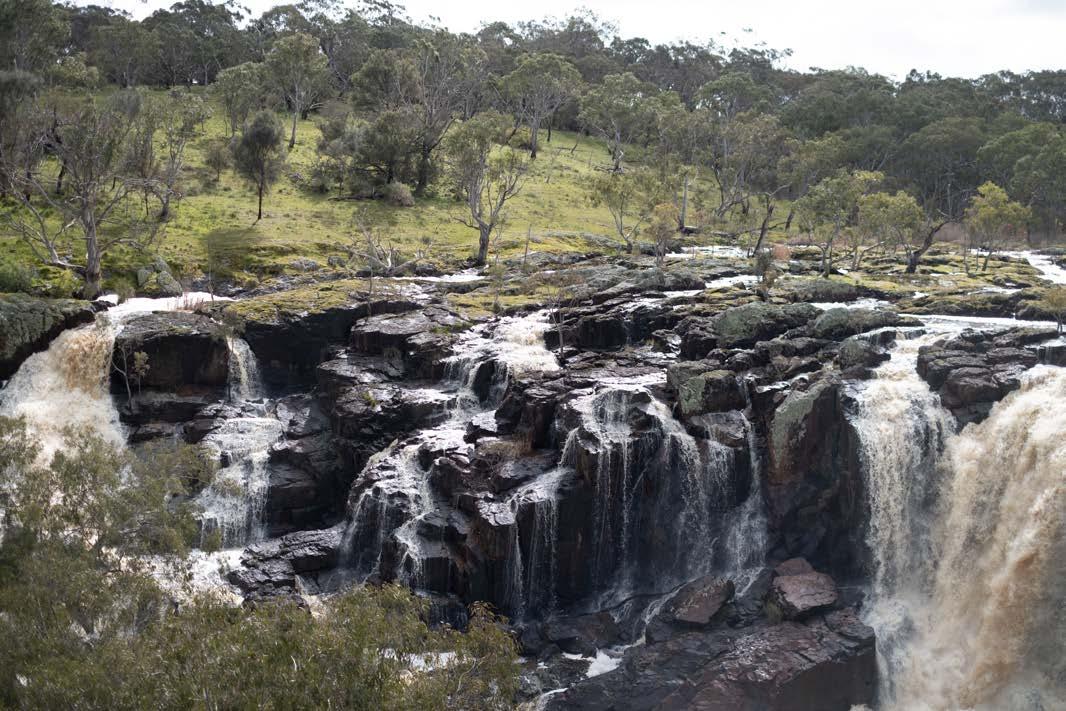
A day filled with lush vegetation, light rain and spectacular and astounding volcanic caves, mountains, waterfalls and valleys.
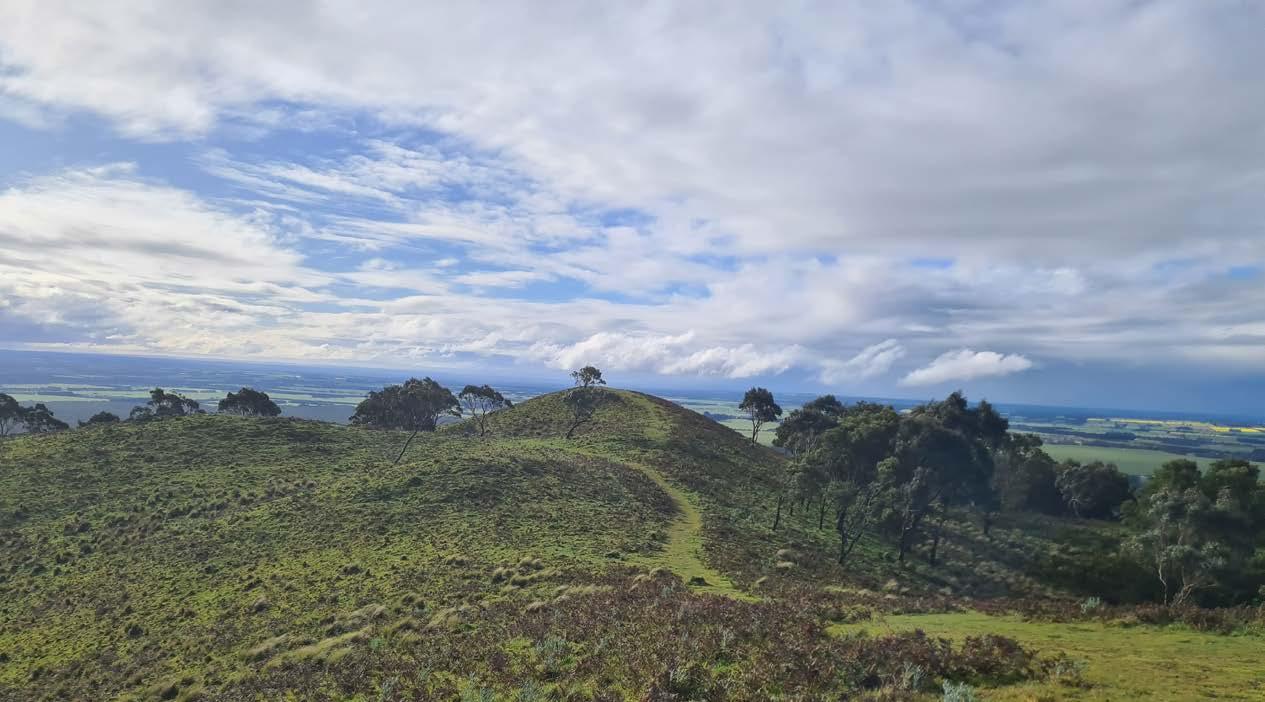
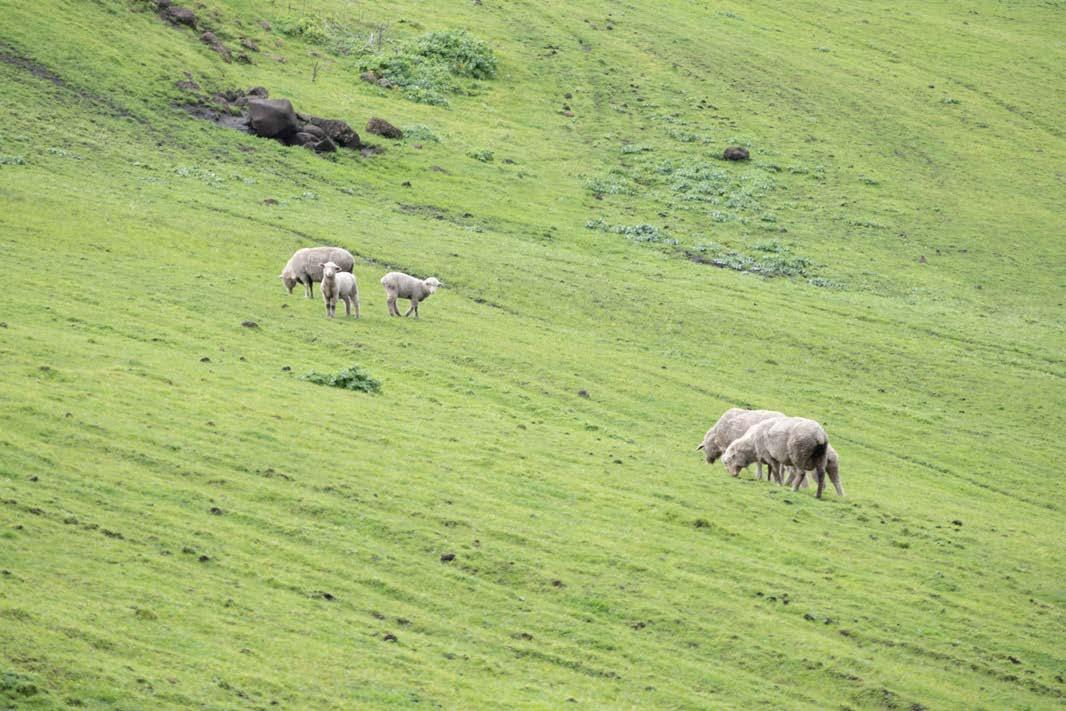

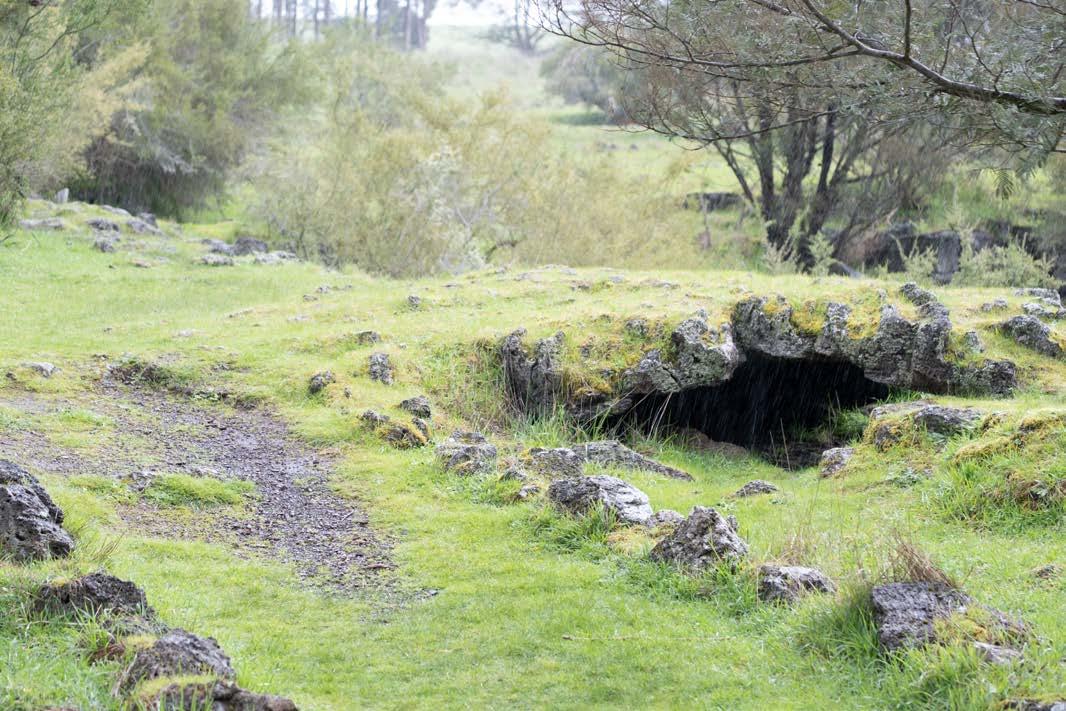

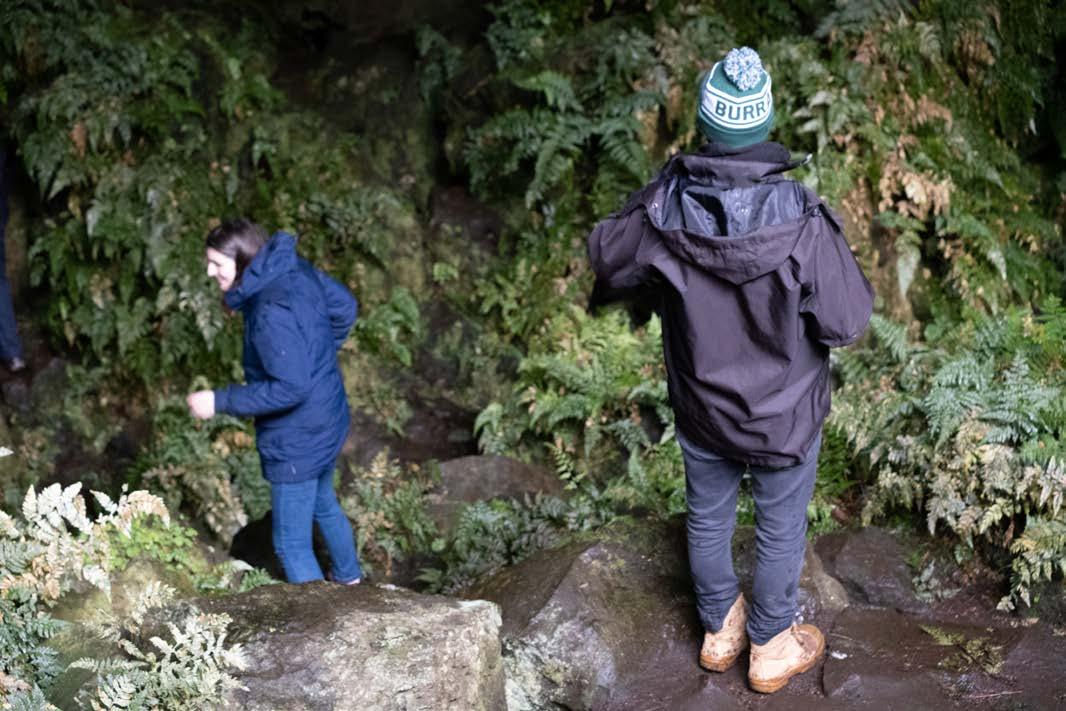
 EMMA
EMMA
Symzonia’s Characters


Grand council of worthiesassemble once every four years
Council of worthies - assemble twice a year


Best man / Chief- Oversee all the time
Outcasts - apart from society & fend for themselves
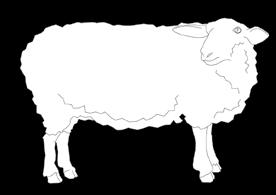



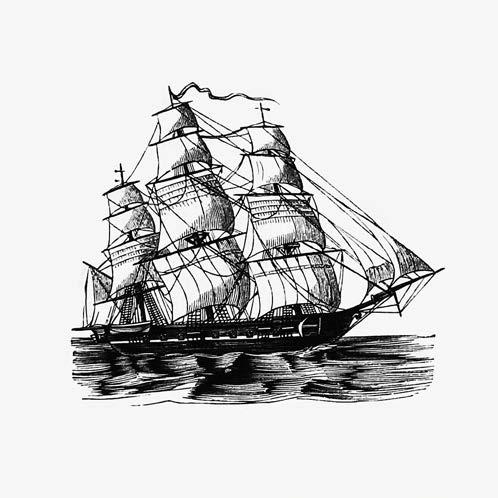



“reflecting upon.. The internals and externals … I perceived that the greater part of the labour of the externals was devoted to the production of things useless or pernicious”. “Thousands of us are employed in producing inebriating liquors…narcotic substances… mere matters of ornament”… “ externals were miserable from the indulgence of inordinate passions” - (Seaborn, A. 1820) hcihW htap w i l l you take?
We must call to action the characters of the underworlds; the other worlds; those that go unnoticed but produce useful and great things.

The Tourist ‘Voyagers’ visit each site, walking along the beaten path and taking part in the actions and amenities placed by the brigades.
The Farmers (‘Grand Council’) are needed where there is an intersection of private land and crown land - inaccessible by any person except them.


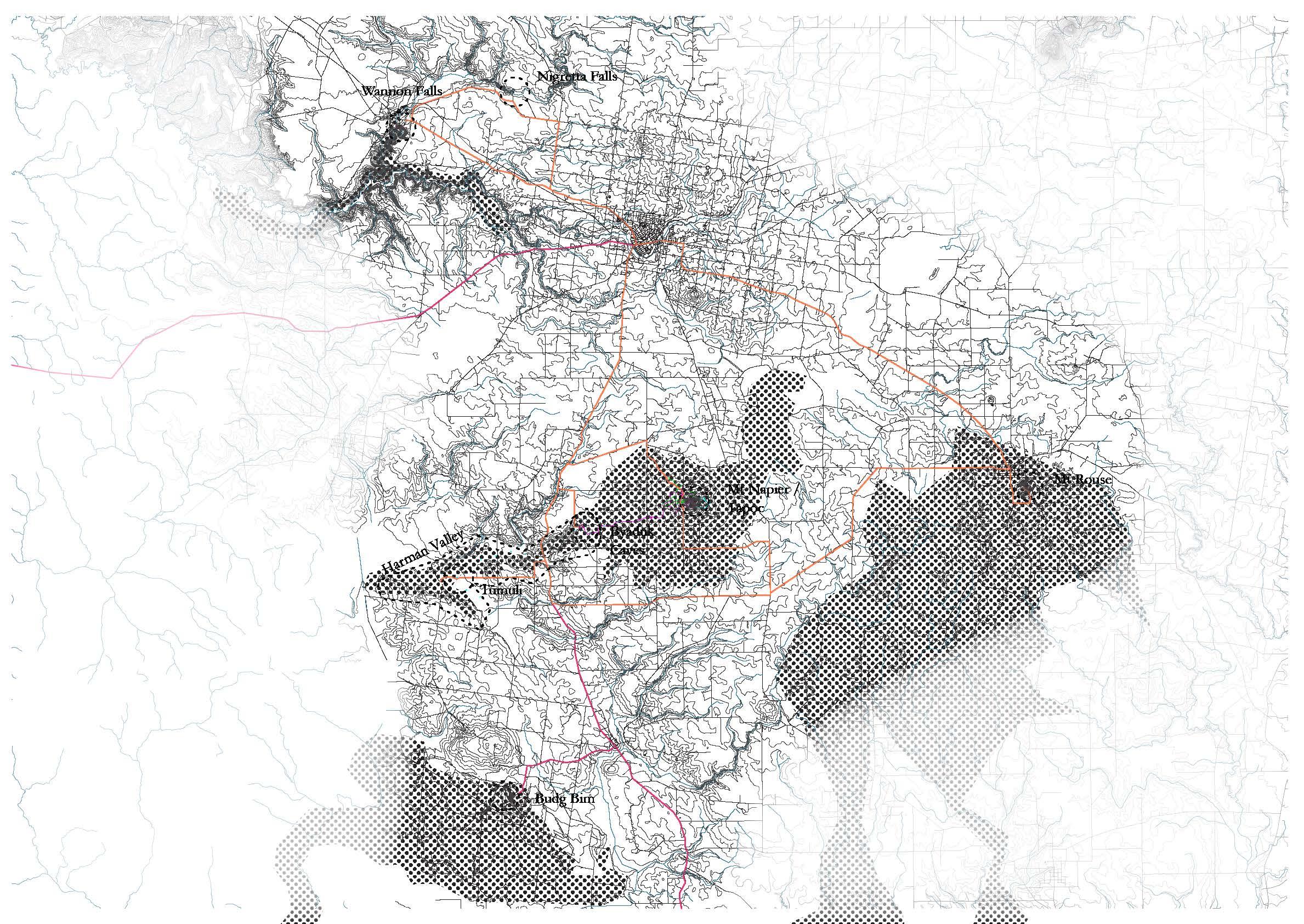
The animals (‘The Outcasts’) roam where they please, only controlled by man’s fences.

Volcanic Sites within Southern Grampians Locality
VVP Trail Old
VVP Trail Proposed Volcanic Flow
The council of worthies and the ‘Best Man’ are needed in the hard to reach places - off the beaten path. The untamed state parks.



The Author curates the experiences and guides each character in their role to play.




Create amenities for the VVP and bring people to the sites.
Plains grassland - public land
Plains grassland - private

Stony rises woodland Rocky cliffs
Fire Burnings at appropriate times

Strengthen the involvement of the Gundijtmara people
Cultural tours yarns, and involvement in building and showing of residences.
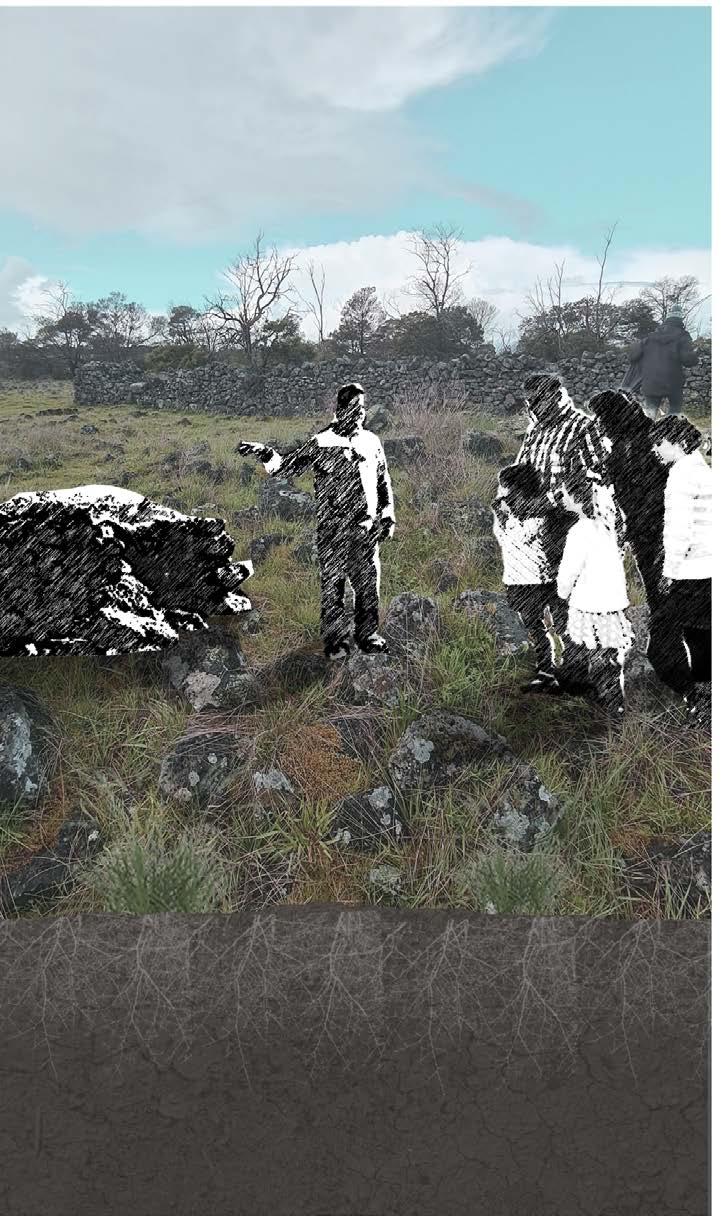
Holes for birds to nest at campsites and rest sites
Create additional paths and way finding for walkers of the VVP
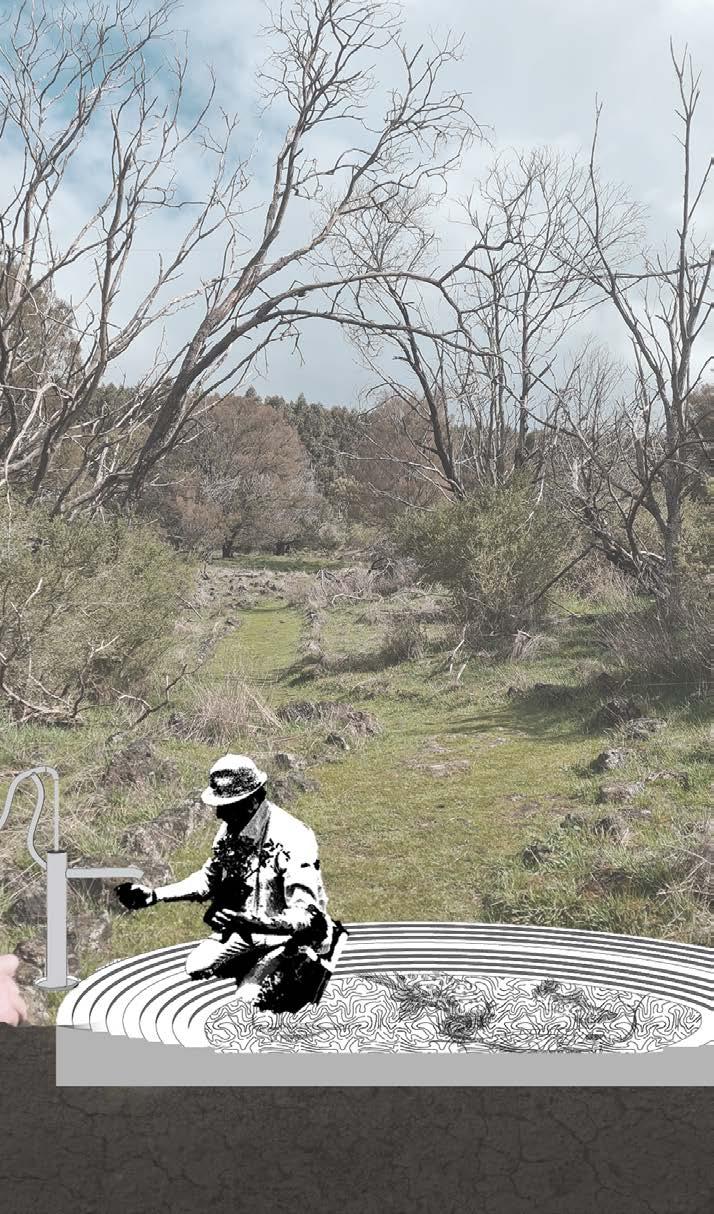



Water capture and supply - bores and water pumps + water pooling down side of trees.
Creation of amenities
Growing Acacia Melanoxylon in vacant land in Eucalyptus plantations
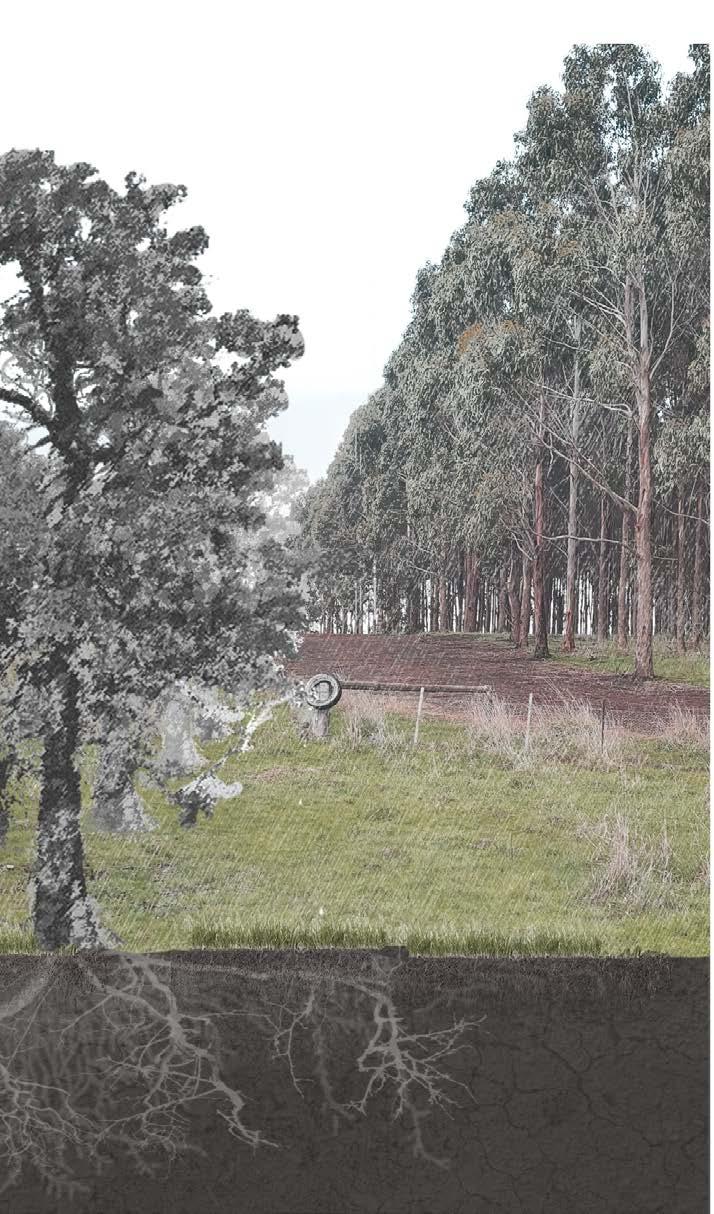


Growing Acacia Melanoxylon for sheep fodder and alleyways for hikers
Scrapings to create micro-climates/ Acacia Melanoxylon markers

 EMMA
EMMA
Placing the actions from the action plan in time.
1. Through the Indigenous seasons (1-12 months)

2. Through the lifecycle of the Acacia Melanoxylon (0-100years)

Actions that the newly formed ‘Eastern Maar Brigade’ will perform mapped through Indigenous seasons



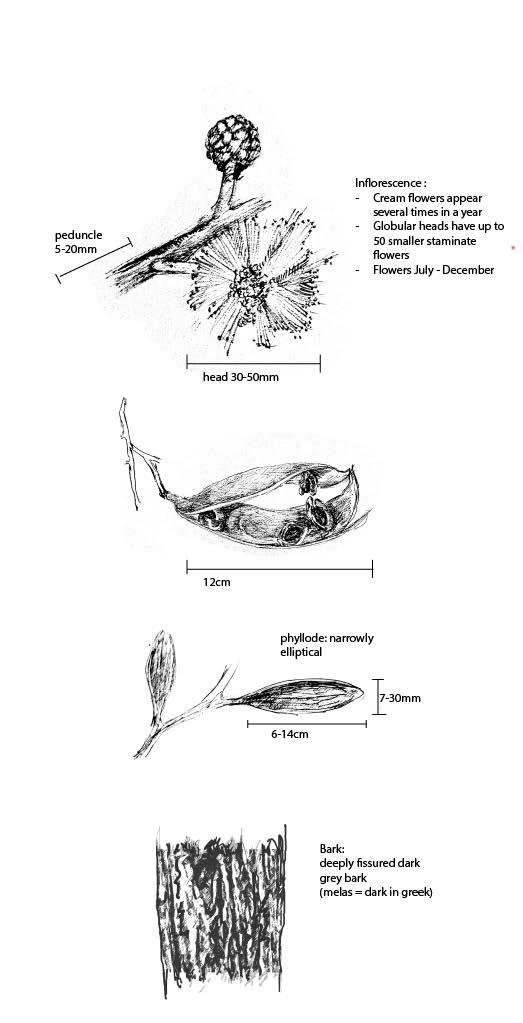

Seeds spread through animal defecation and ants burying them underground

Nitrogen fixing roots, growing in sand, silt and clay with a clayey subsoil
Will grow basically anywhere and survive basically anything

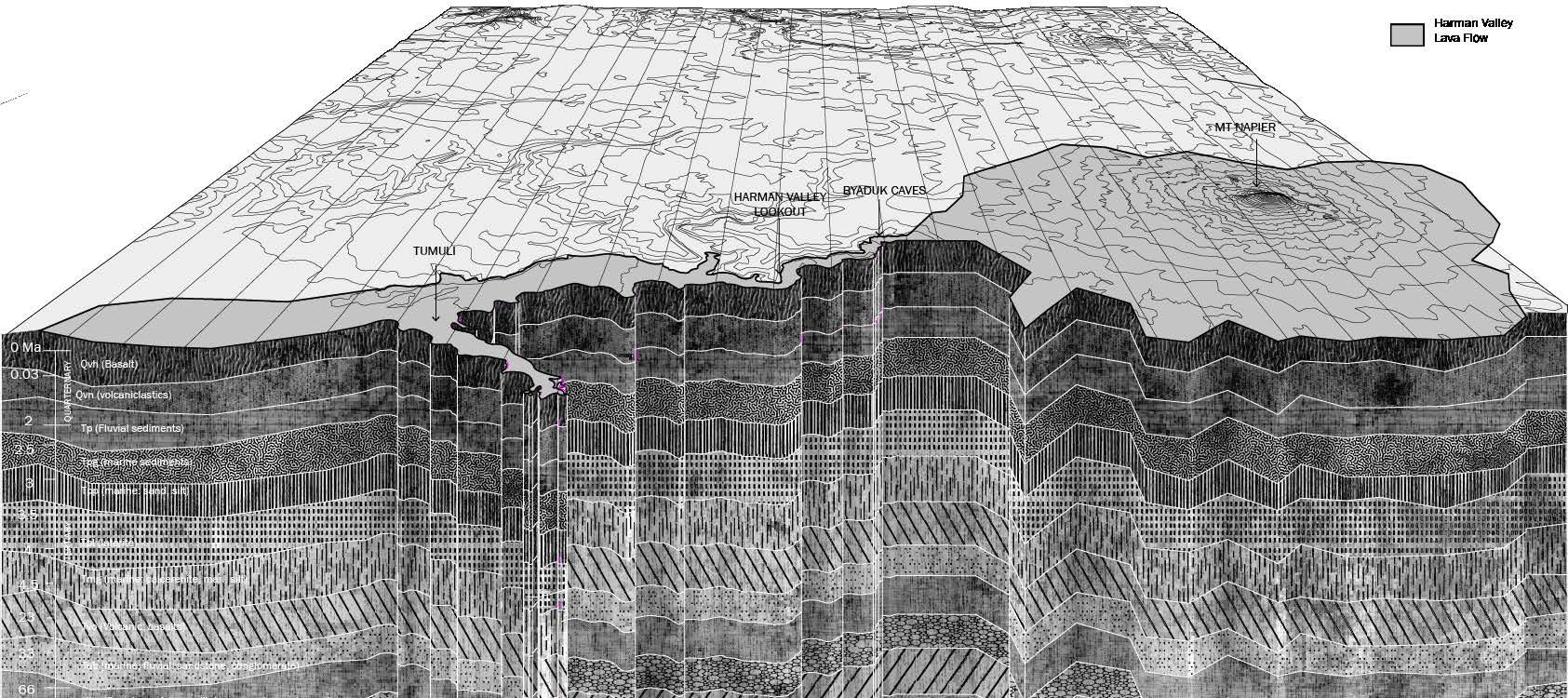

MWalking the Harman Valley is more of a wayfinding exercise than a trail


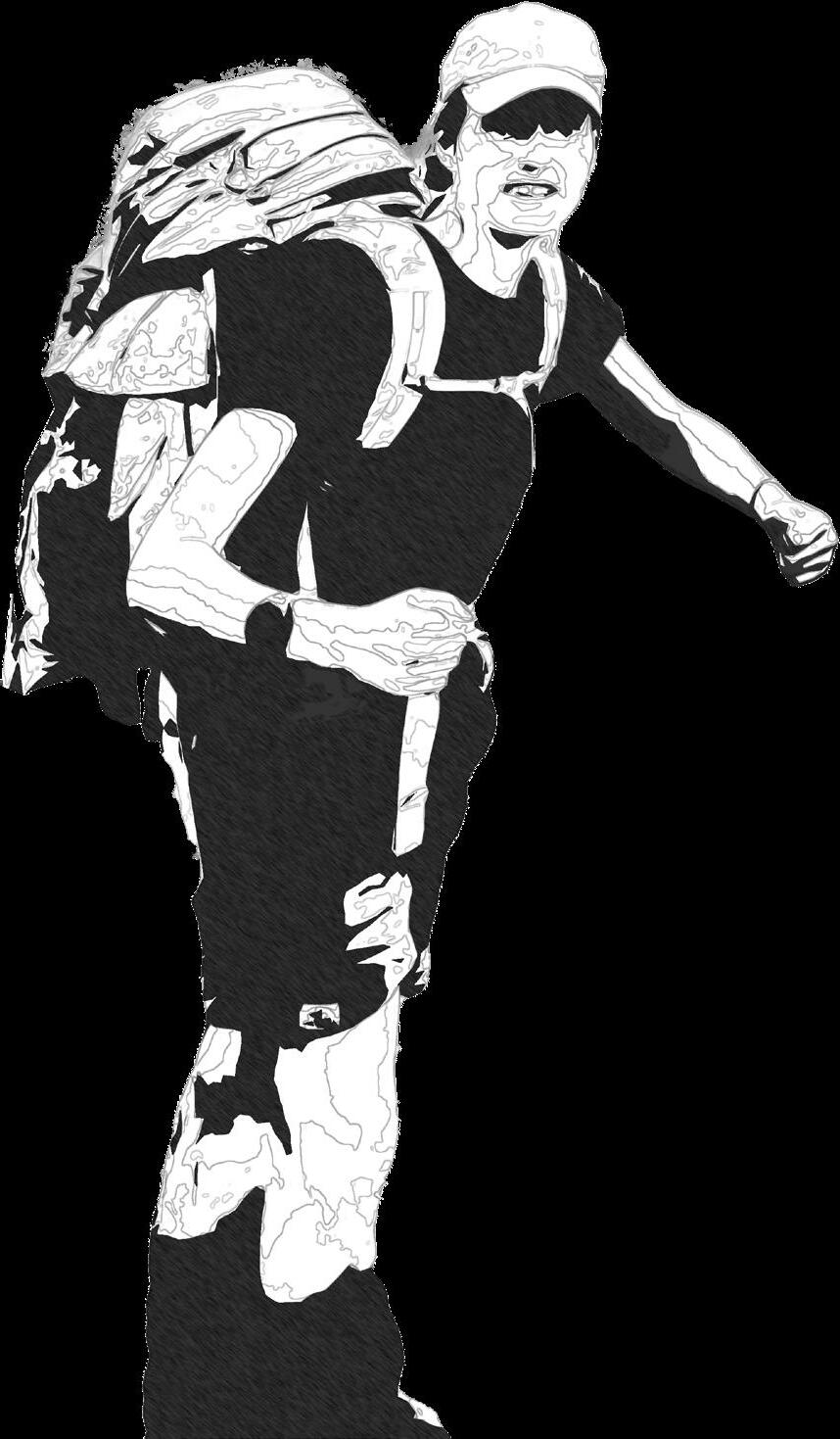 Geological Section
Geological Section
from the lava ridges and depressions
The lava ridges, tumuli and depressions form its own wandering path through the Harman Valley. The design action here is to create wayfinding moments. These moments will be reproductions of vegetation from millions of years agocreated by first planting Acacia Melanoxylon to create canopy shade.
The moments are 1km apart for a bee to able to carry pollen between the sites. The larger sites will be 5km apart for as far as the human eye can see




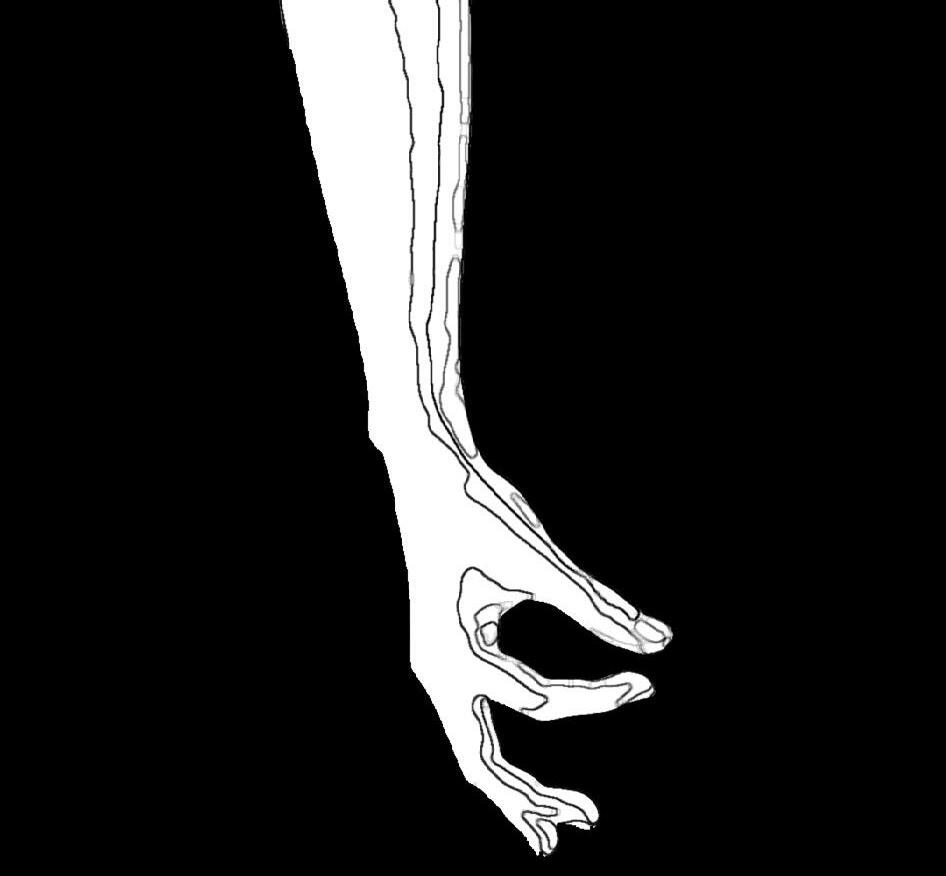
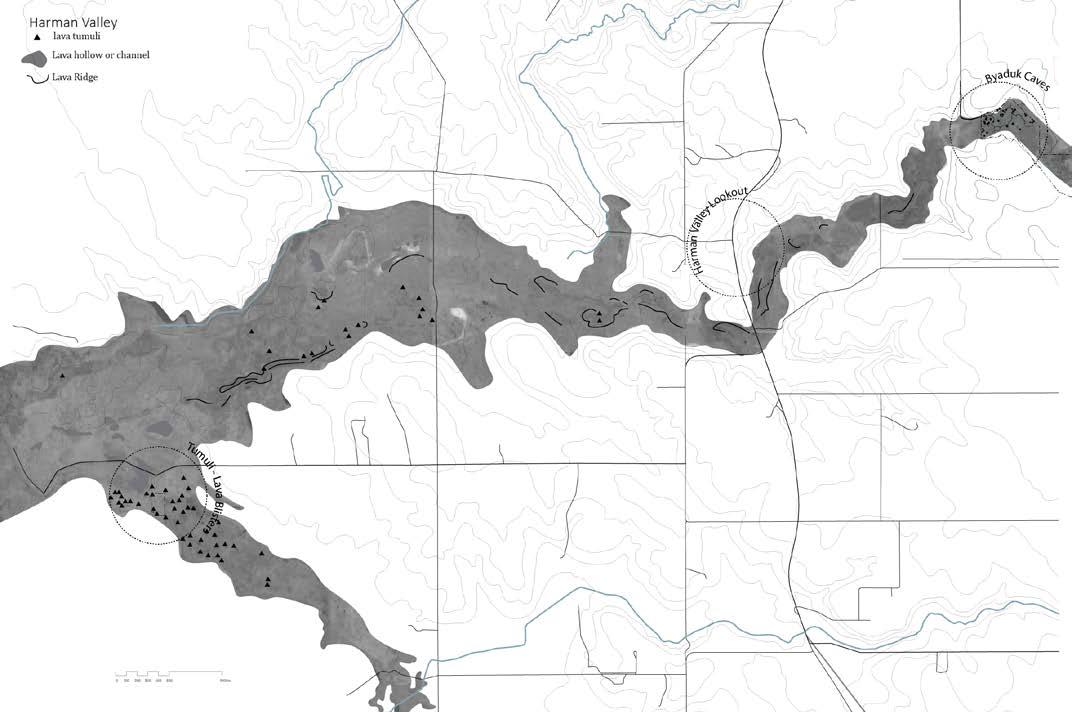

After the scrapings are done, we can plant the Acacia Melanoxylon at multiple loactions and for multiple uses
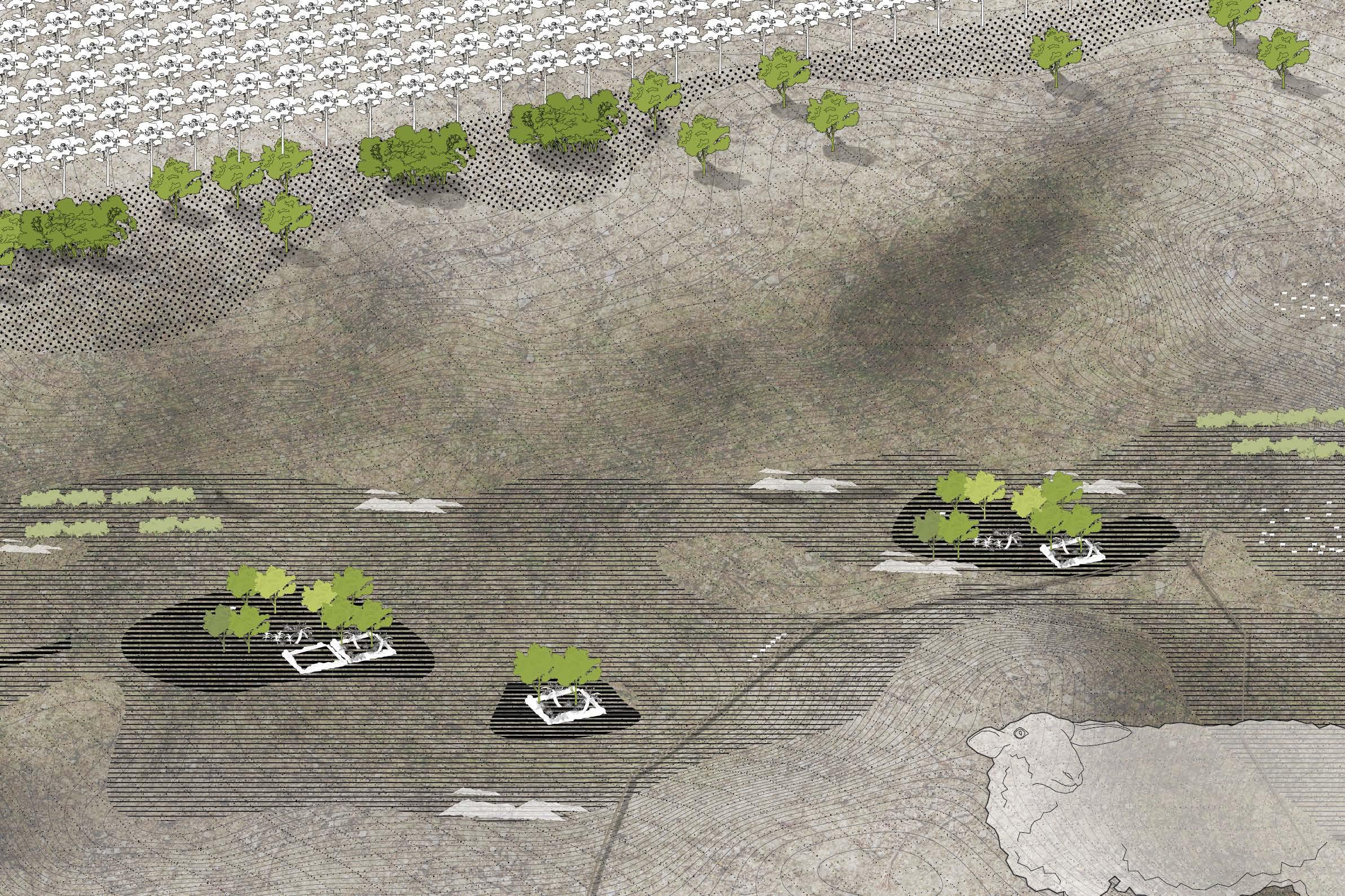

I play a huge part in maintaining the height of the Acacia Melanoxylon




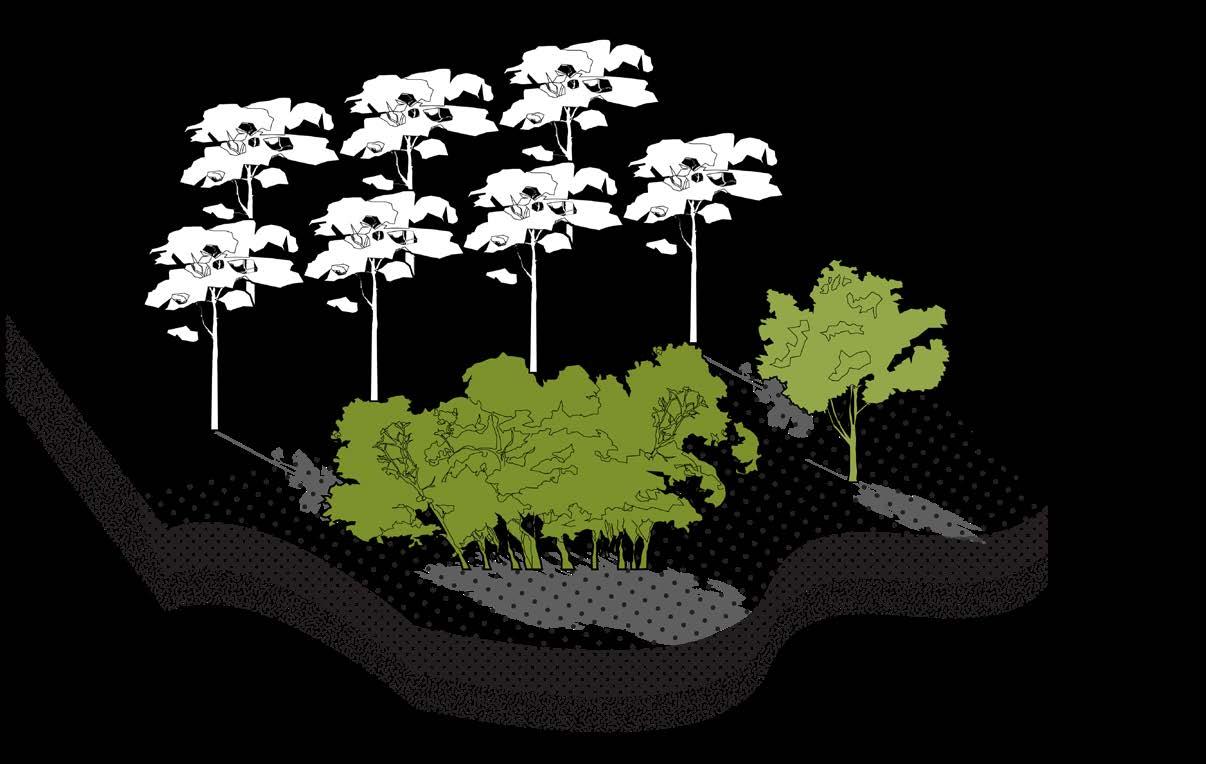



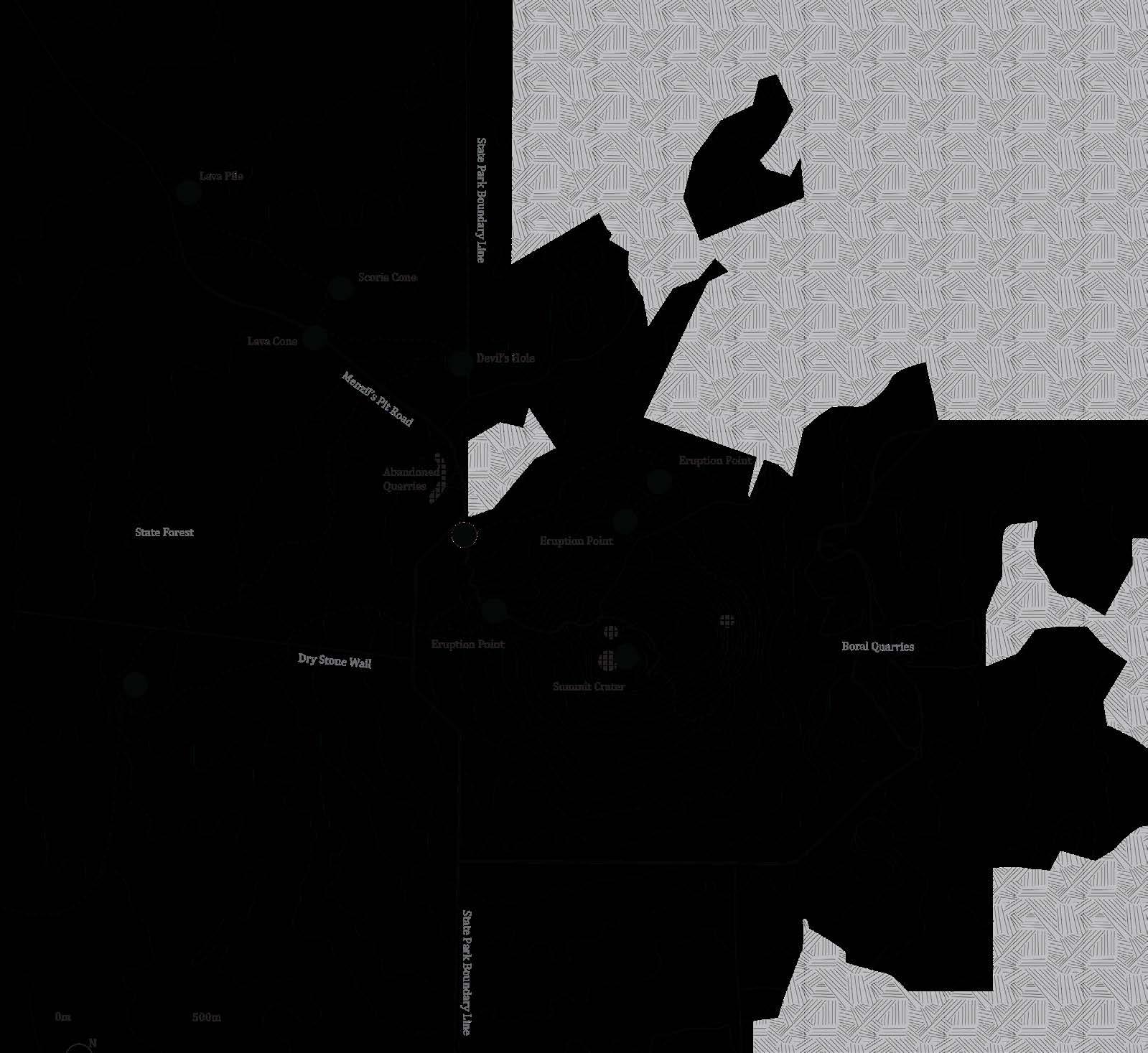





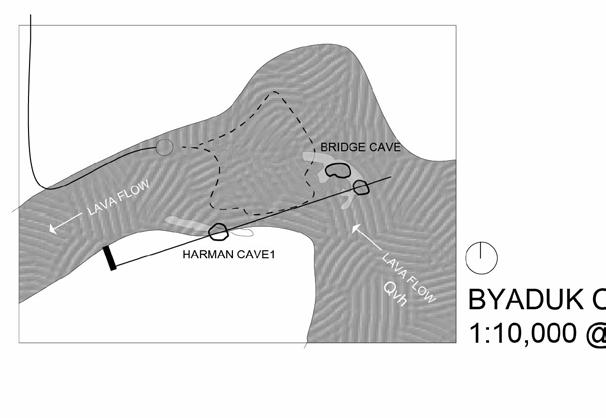





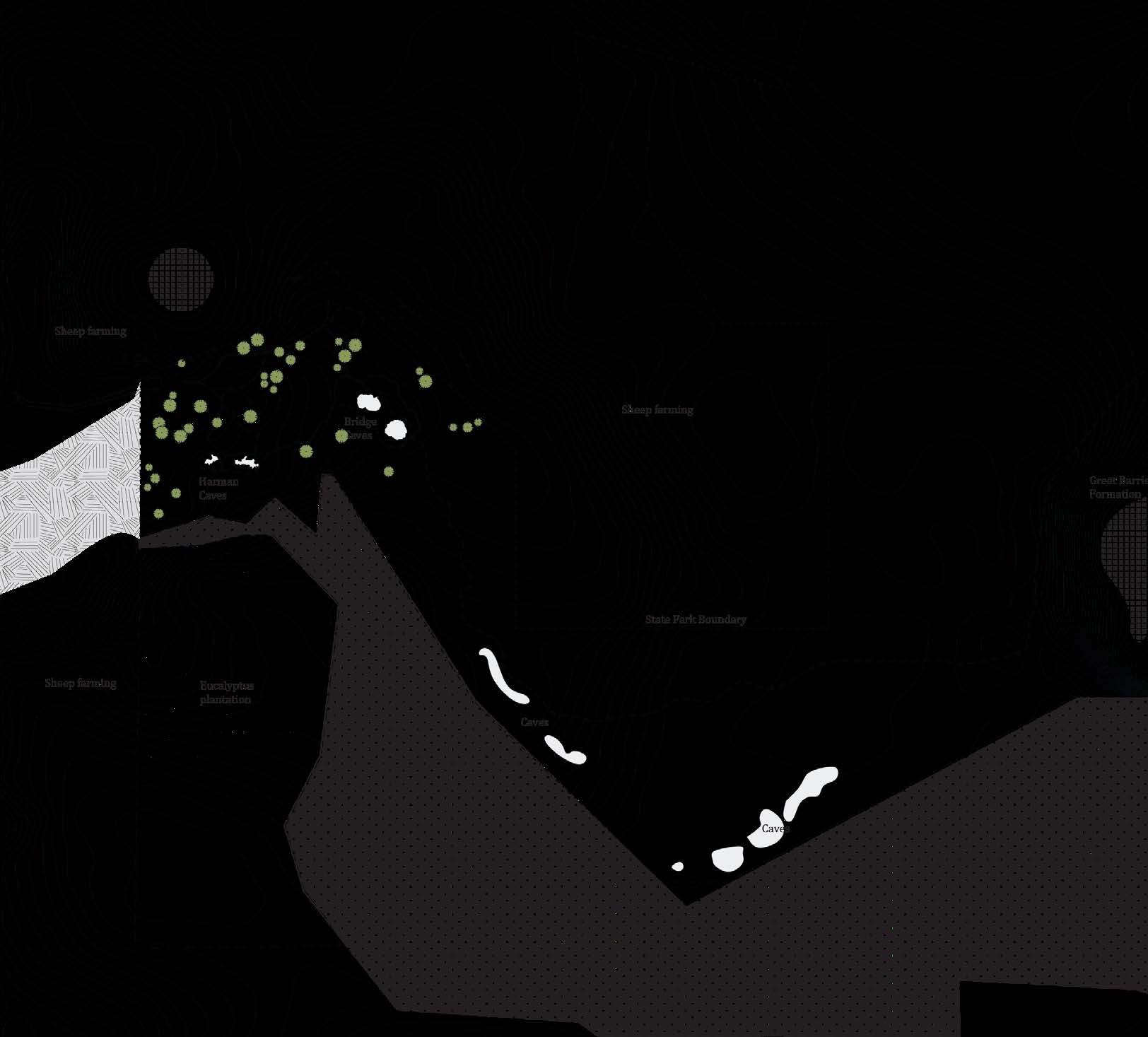

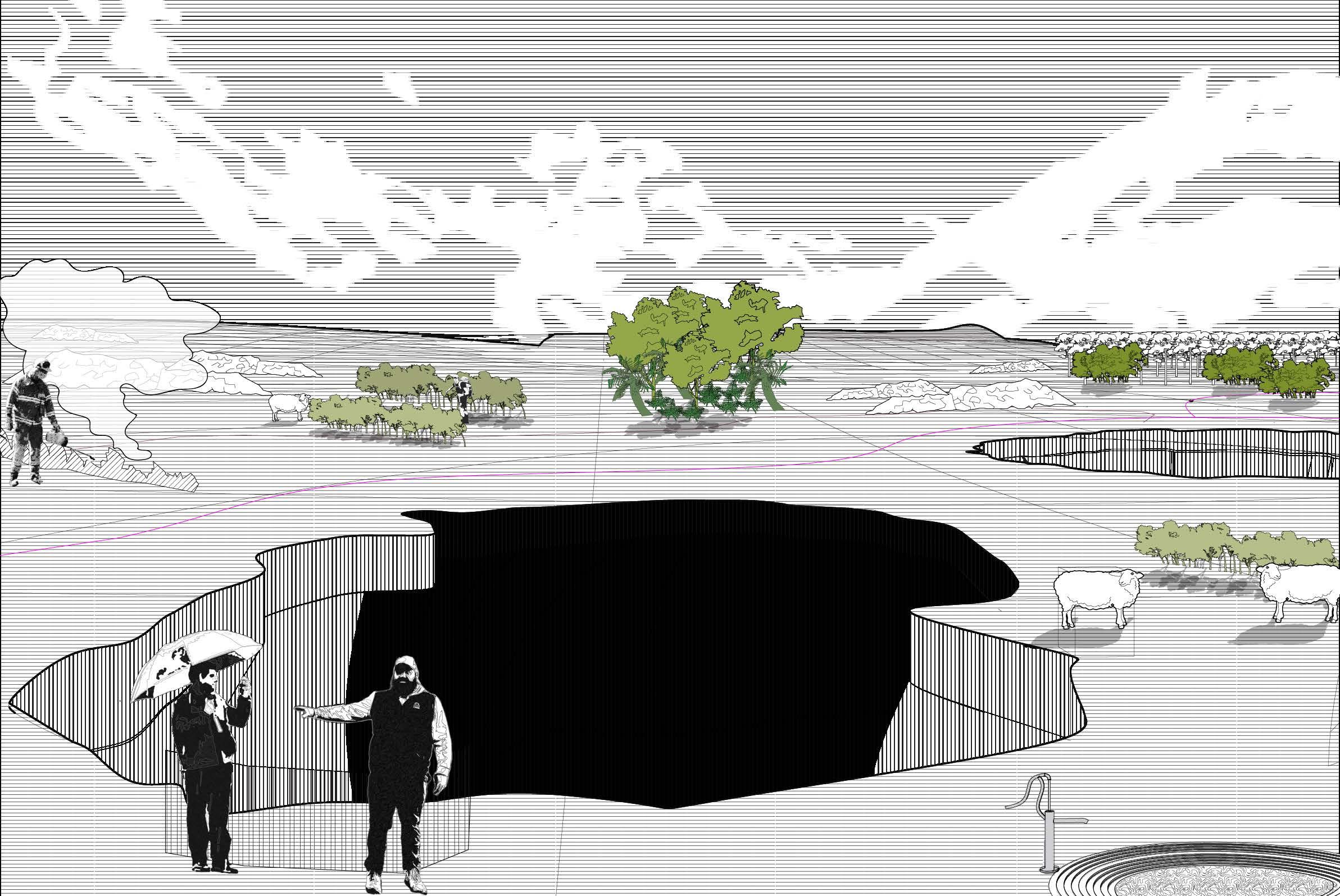
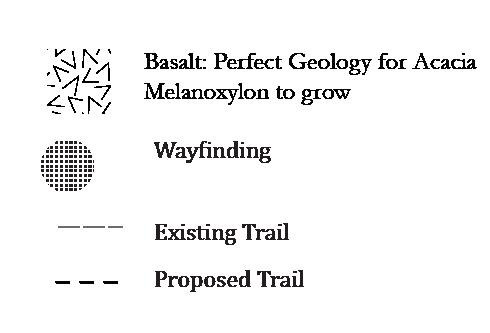

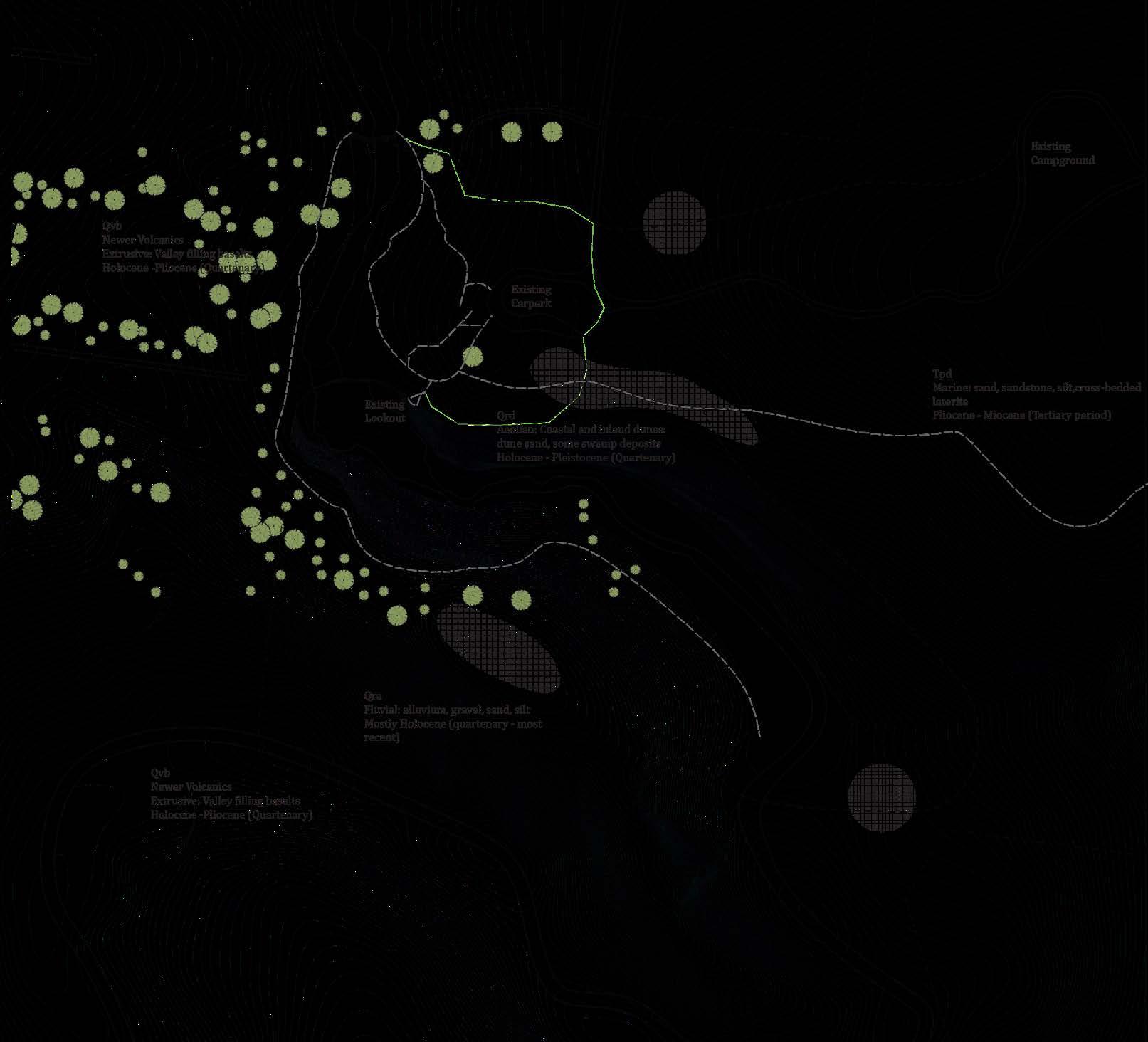





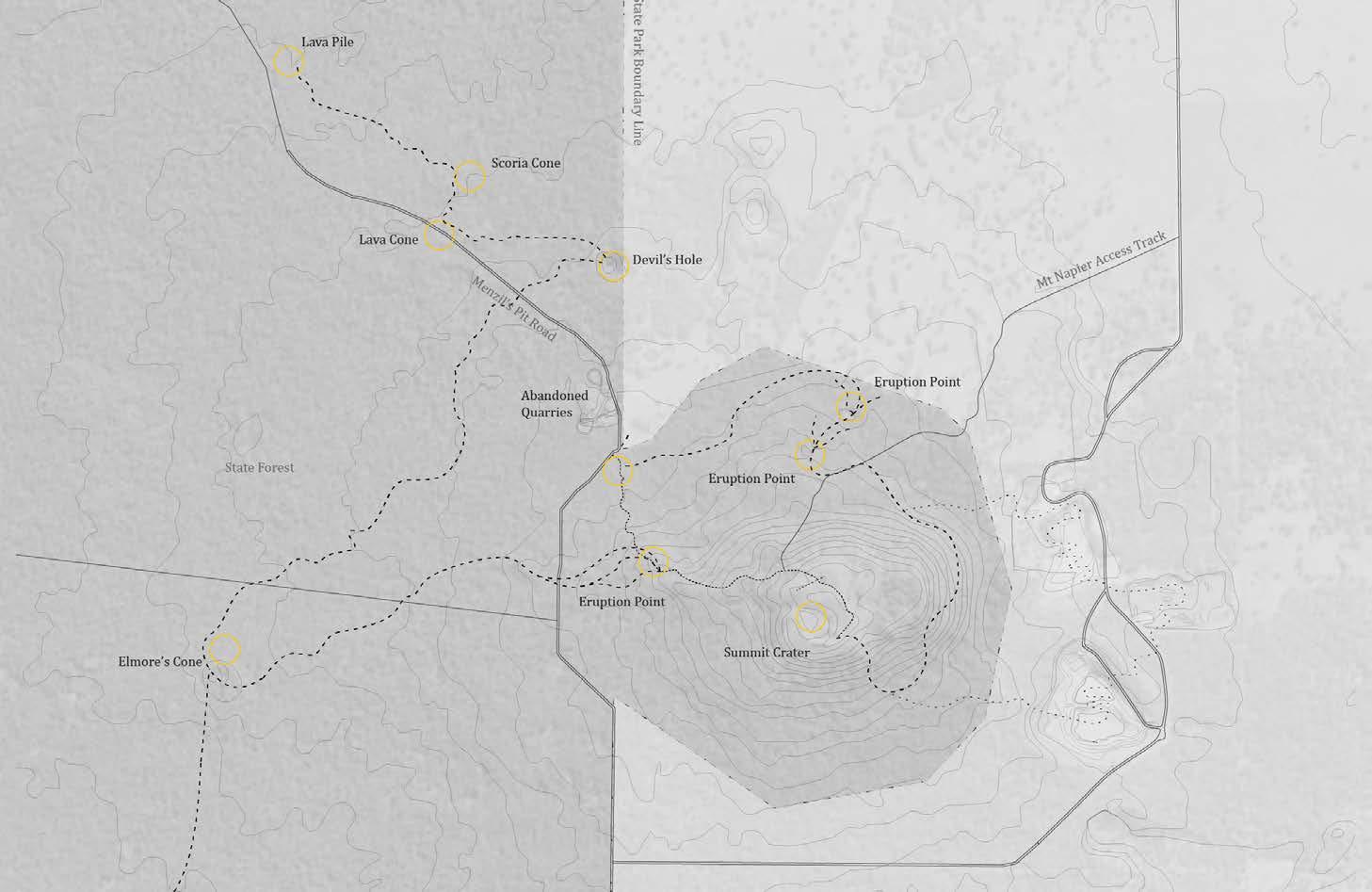





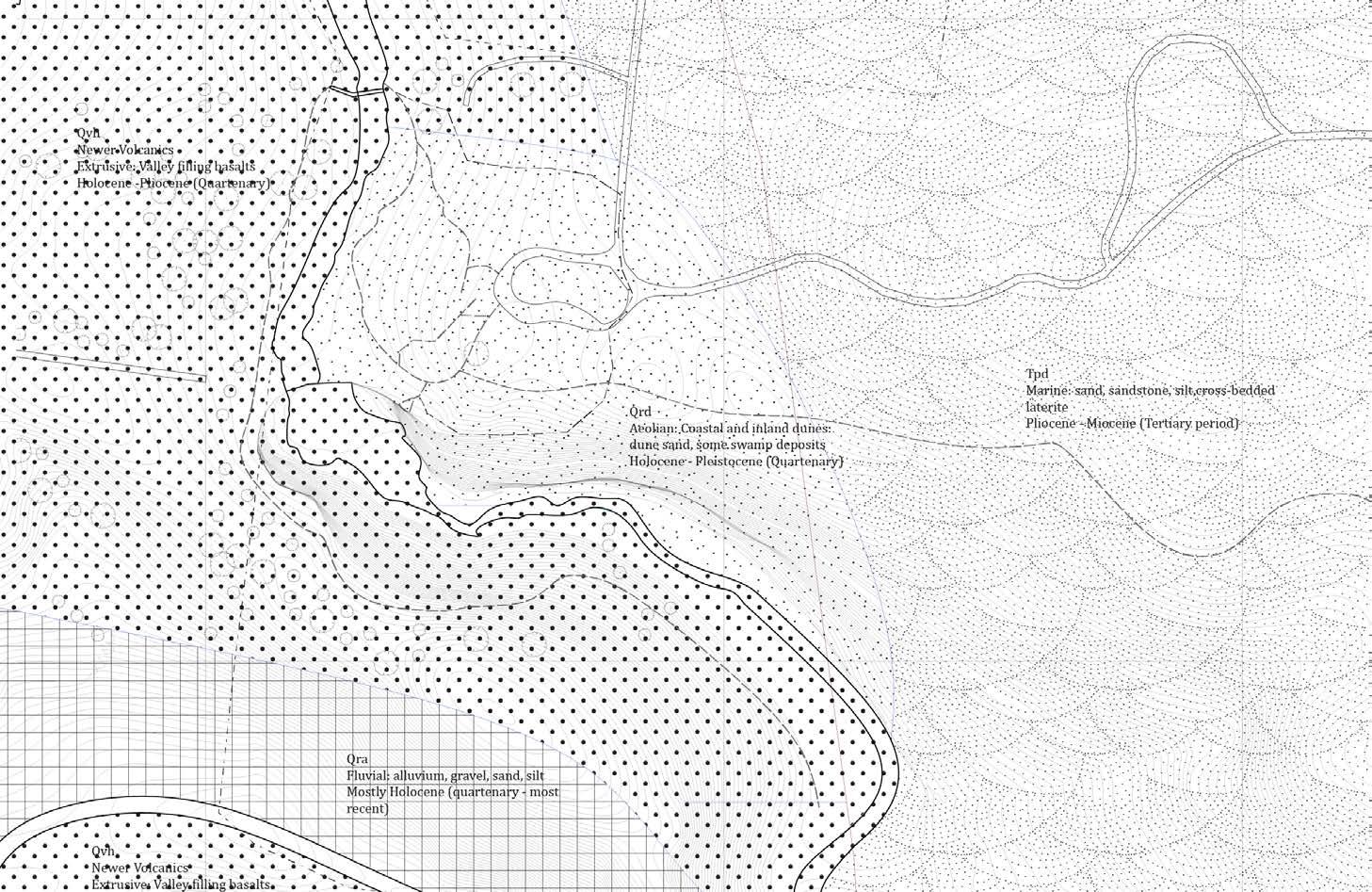




Plains grassland - public land


Plains grassland - private land Stony rises woodland Rocky cliffs
LCreate additional paths and way finding for walkers of the VVP
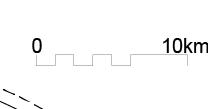



The existing Victorian Volcanic Plains Trail
Extending the Victorian Volcanic Plains Trail Southern Grampians Shire Southern Grampians Shire





The larger Kanawinka Bioregion has breathtaking volcanic sites washed across all of Victoria and into the East of South Australia.
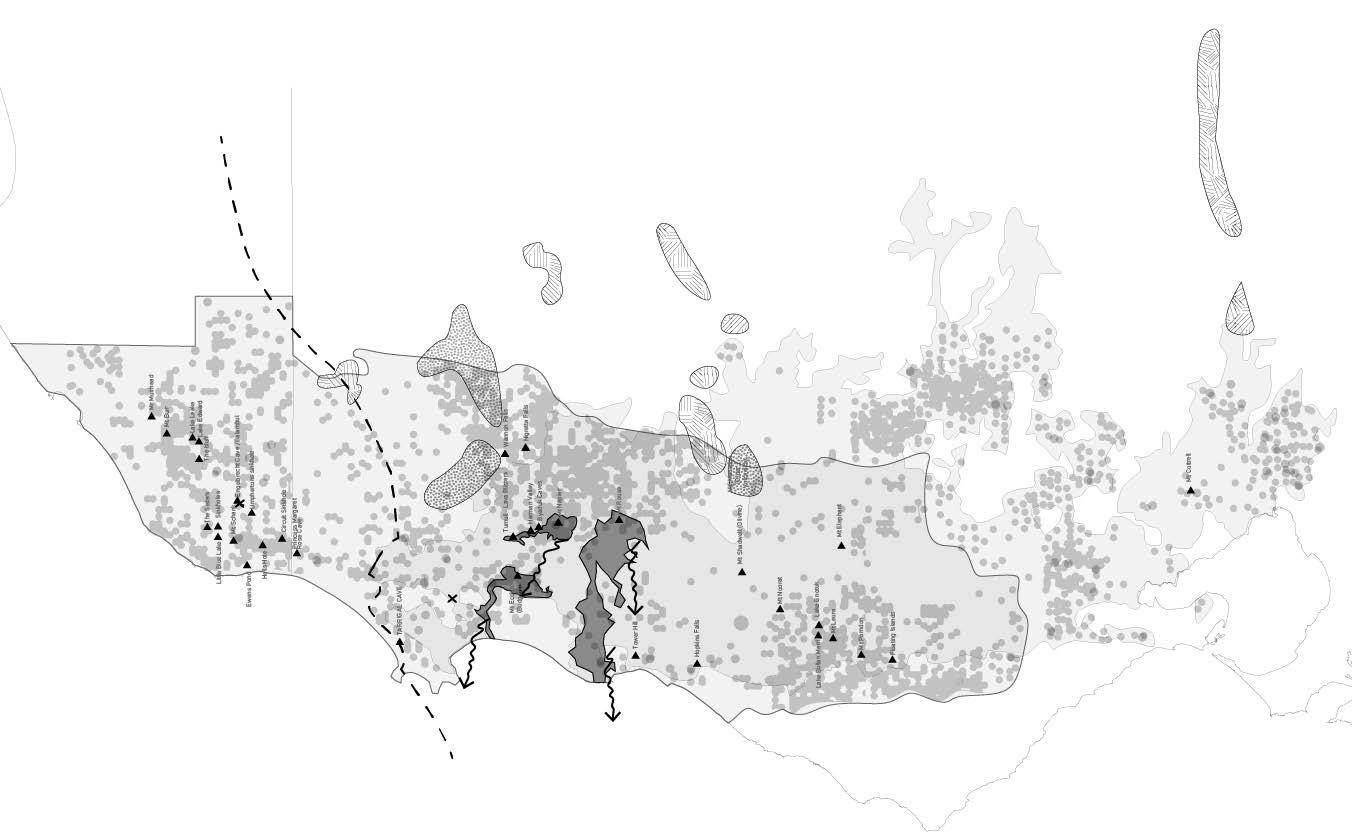
Newer volcanics caused the Southern Grampians volcanic plains’ sites to be established, but upon mapping the volcanistic geology and the wider site, the groupings of the region becomes apparent.











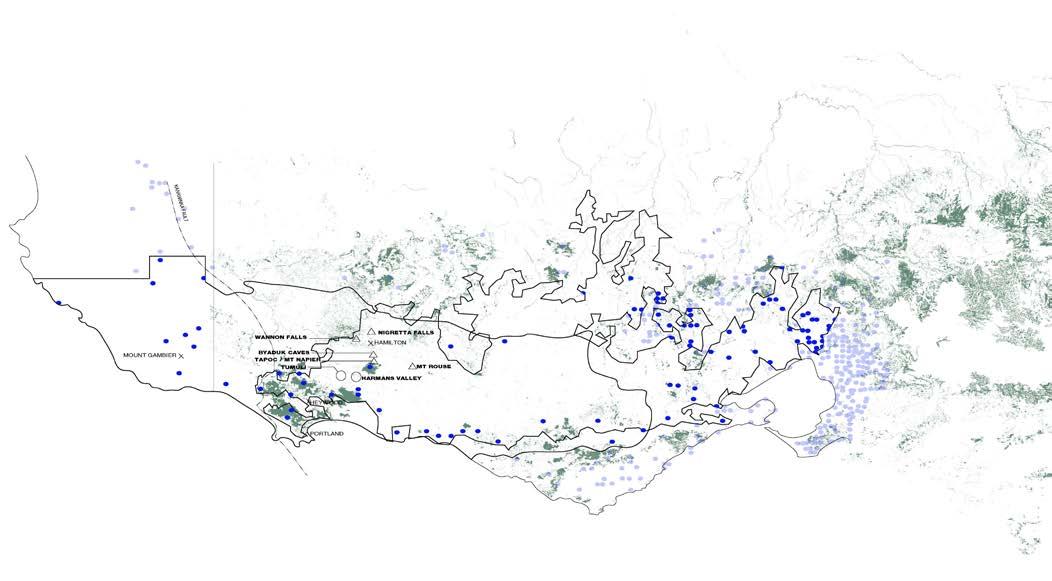


“The air vessel over the boat was charged with an elastic gas”

“instructed me in the civil polity, customs, manners, and habit of this people”
“their cloth is a beautiful substance… species of insect, larger than our spider, produce it in great abundance”
“statistics, geography, botany, aerology, geology, mineralogy, zoology, ornithology, ichtheology, conchology, and entomology, in turn demanded my attention”
“reflecting upon.. The internals and externals … I perceived that the greater part of the labour of the externals was devoted to the production of things useless or

pernicious”. “Thousands of us are employed in producing inebriating liquors…narcotic substances… mere matters of ornament”… “ externals were miserable from the indulgence of inordinate passions”
Reflection of our society : Our material labour often leads to things unnecessary.
A review of Symzonia points out its satirical nature and prods at the nature of materialism.
‘parodic…but not of the outlandishness of Symmes’s theories themselves’ and is instead ‘a critique of US and British imperialism…a jape at the genre of writing produced by imperial ventures.’ (Blum, H, 2012 p. 261)
“what is not acknowledged” - when defining the areas for change, French mapped what was left out, what was not usually included in the map to reveal that which needed to change.
“place each action in place and time”
“had people but no money”
I aspire to to do a similar project where there would be a low budget but volunteers and teams of people able to be deployed.
(French, 2022)(Garten + Landschaft 2019).
First step: increase soil moisture with in-ground watering system
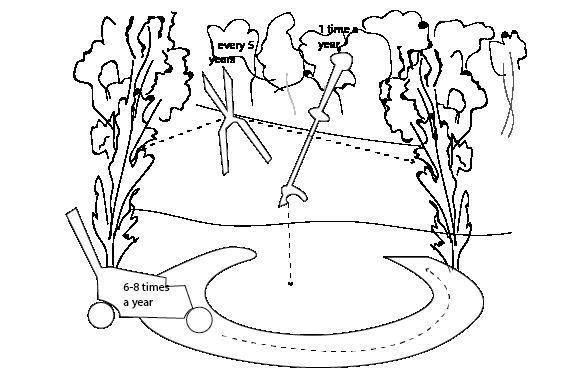
Second Step: Establish canopy
Fast-growing plants typical of the rainforest verge, mainly acacias such as A. melanoxylon (blackwood), A. binervata (two-veined hickory), and A. elata (cedar wattle or mountain cedar wattle), were put in as nurse species around the edges of the gully.
Third Step: Establish understorey - planting of tree ferns
Fourth Step: Set up misters (Beer, 2021)

This studio has taught me that sometimes a small action can have greater weight than a large, physical design.

I would like to take this further by including a policy document for Parks Victoria, Tourism Victoria and Tourism South Australia that suggest a coordinated approach. It would be interesting to explore how a change in policy could effect the larger scale and act as a design mechanism.
Further explorations of the moments where state park boundaries meet private land and how these interactions could be curated to work together would add an extra layer of depth to this project.
This project lacks the specifics of the specific trail types that would play out across the land. If this project were to continue, I would further explore the effect of soil types through deep, geological time on the Acacia Melanoxylon and designing this into the trail. I would have also like to have explored how the trail itself could change at the specific sites.
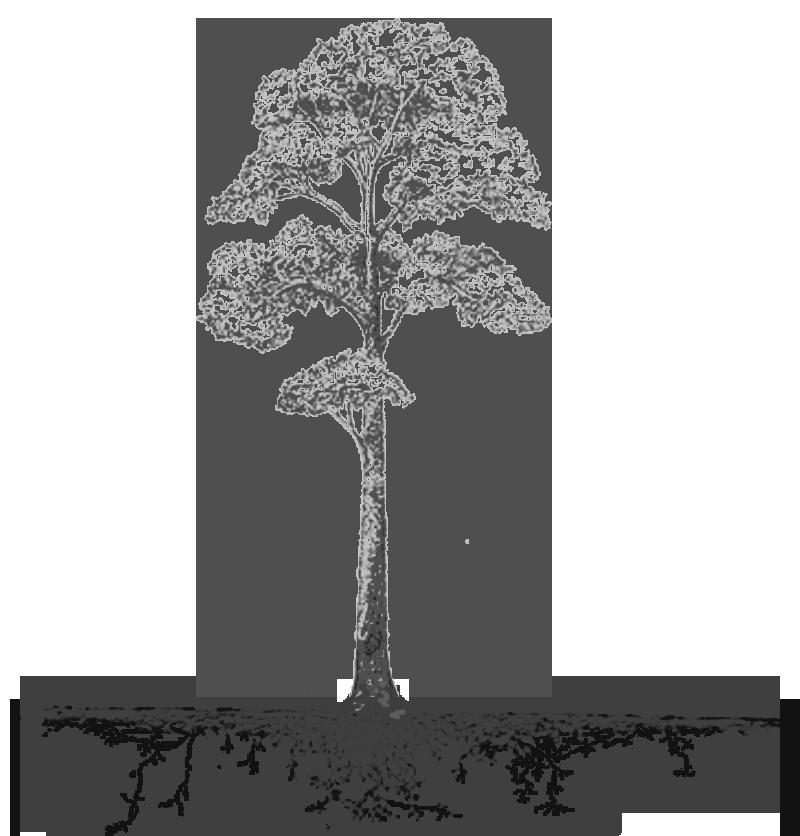



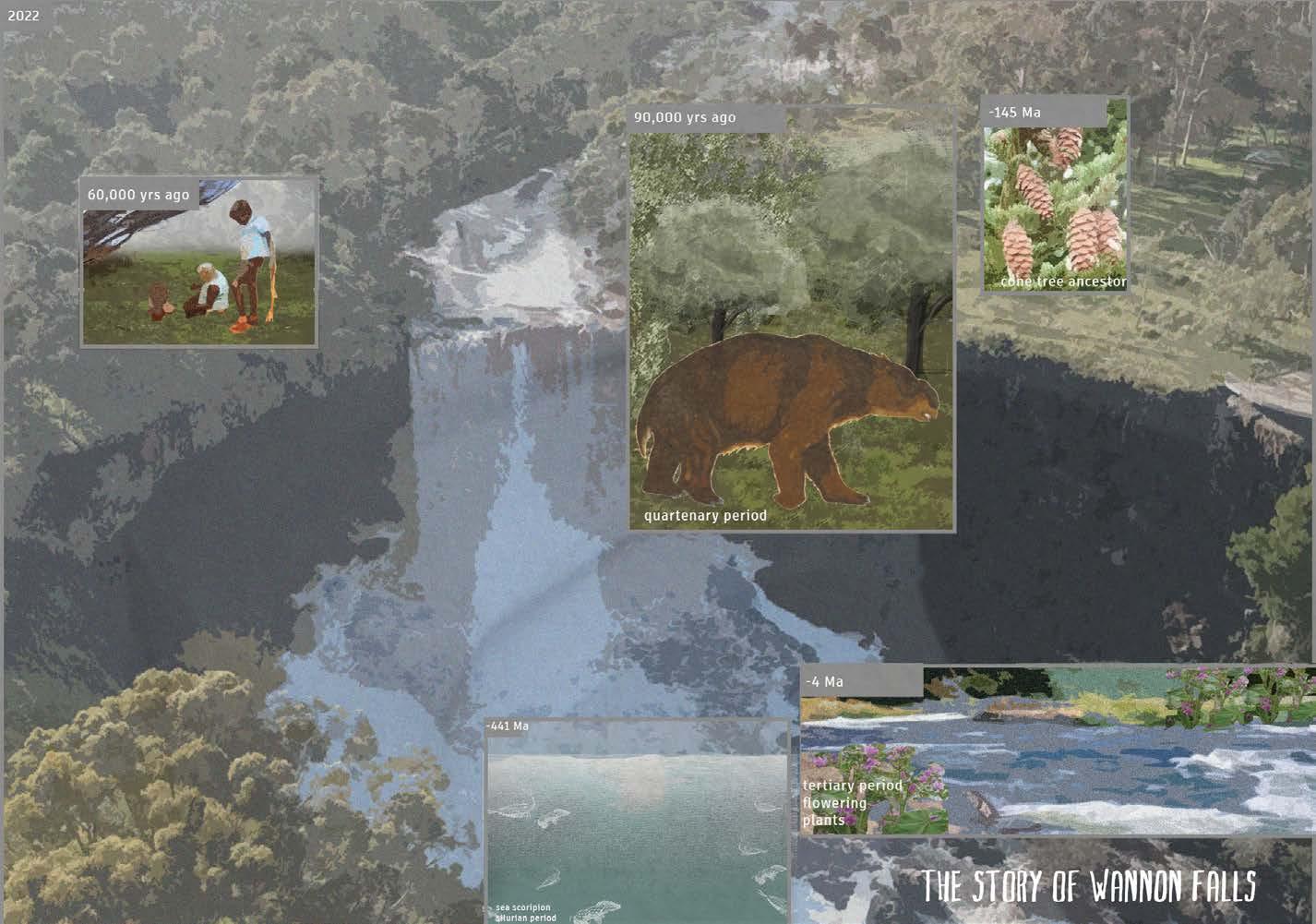




The story of ‘Where the Acacia Went’ and ‘Where the Acacia is Going’
Precedent: Richard Mcguire, Here (Ware, C 2014)










Moving into the quarry, alternative signage shows the history of the area
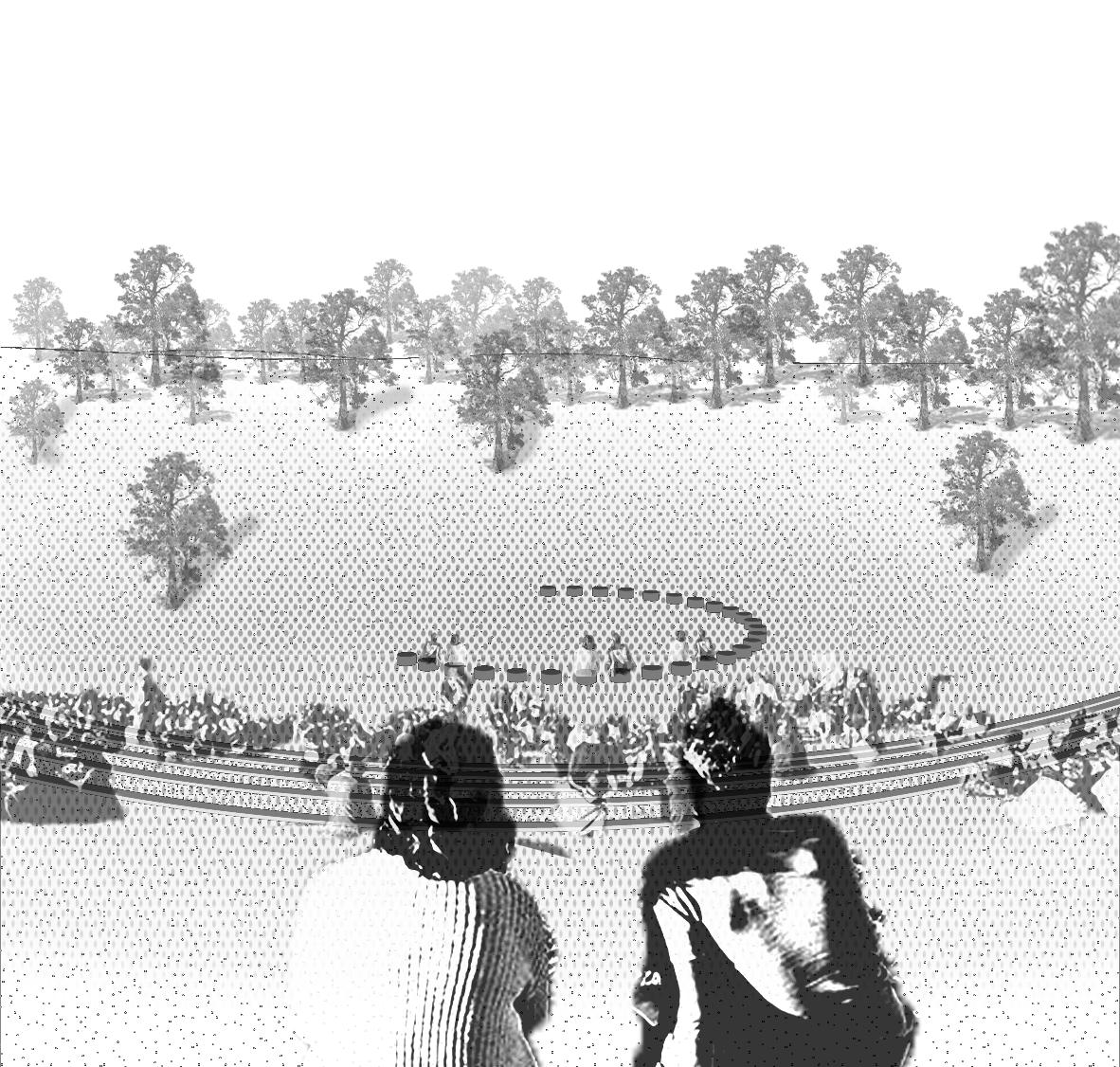

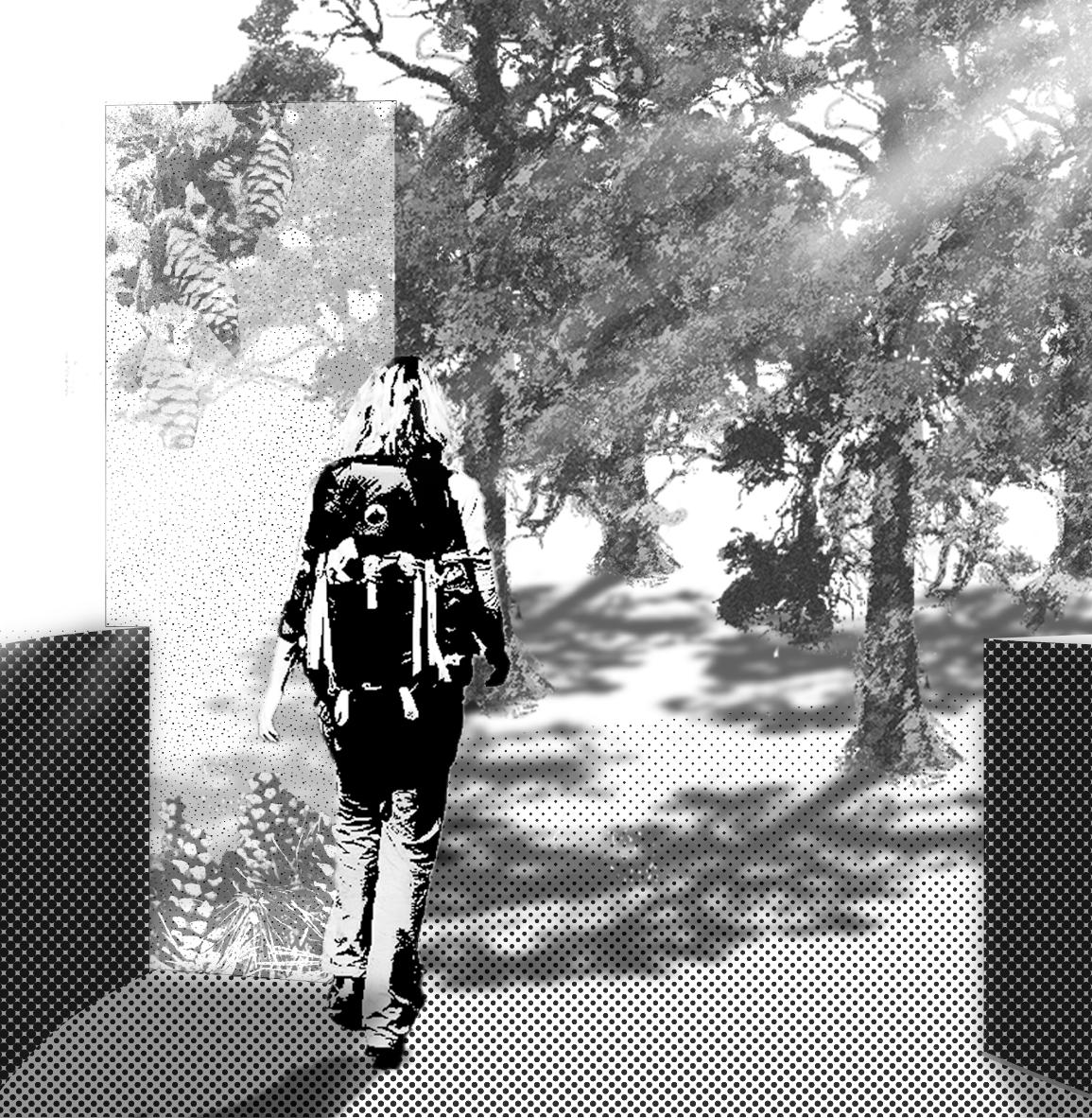

 EMMA
EMMA
The abandoned quarry become a place for birds to nest within the original bomb holes and man made holes - an active process of design rather than static. The campsite then becomes a haven for the acacia as the basaslt has already been revealed, and the birds can spread the seed.

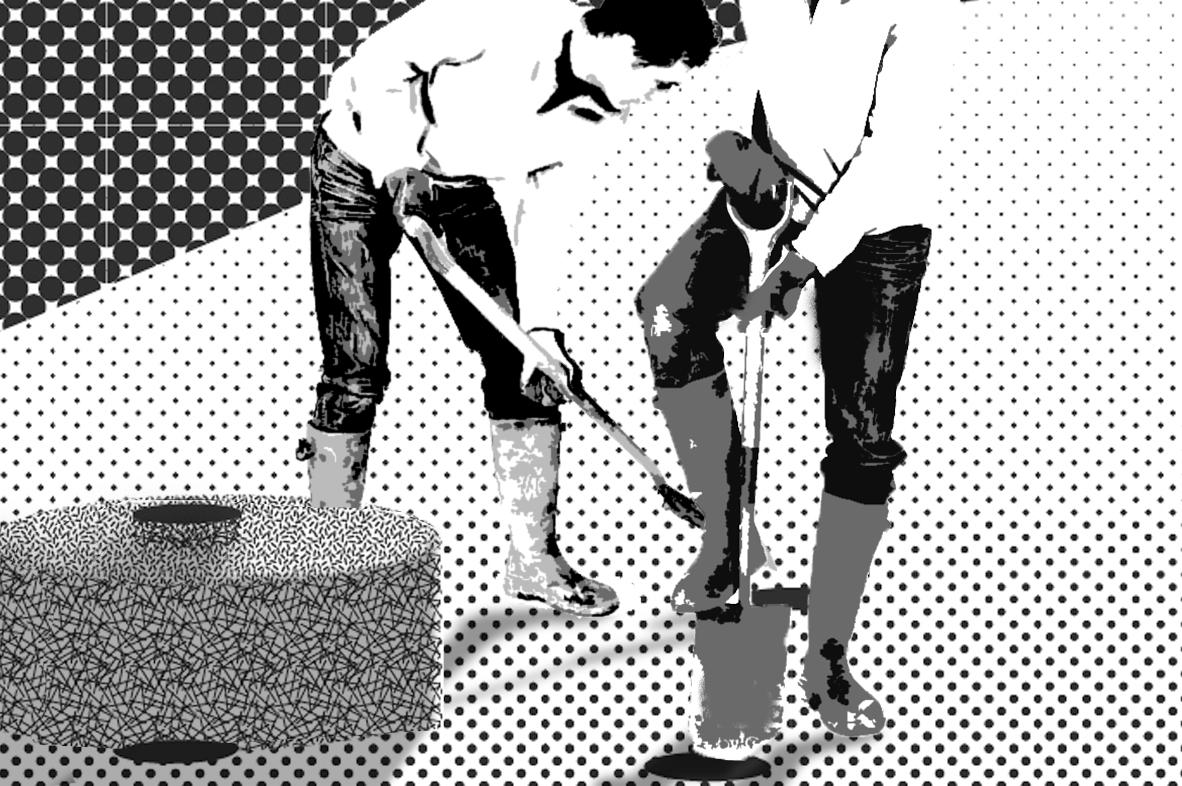
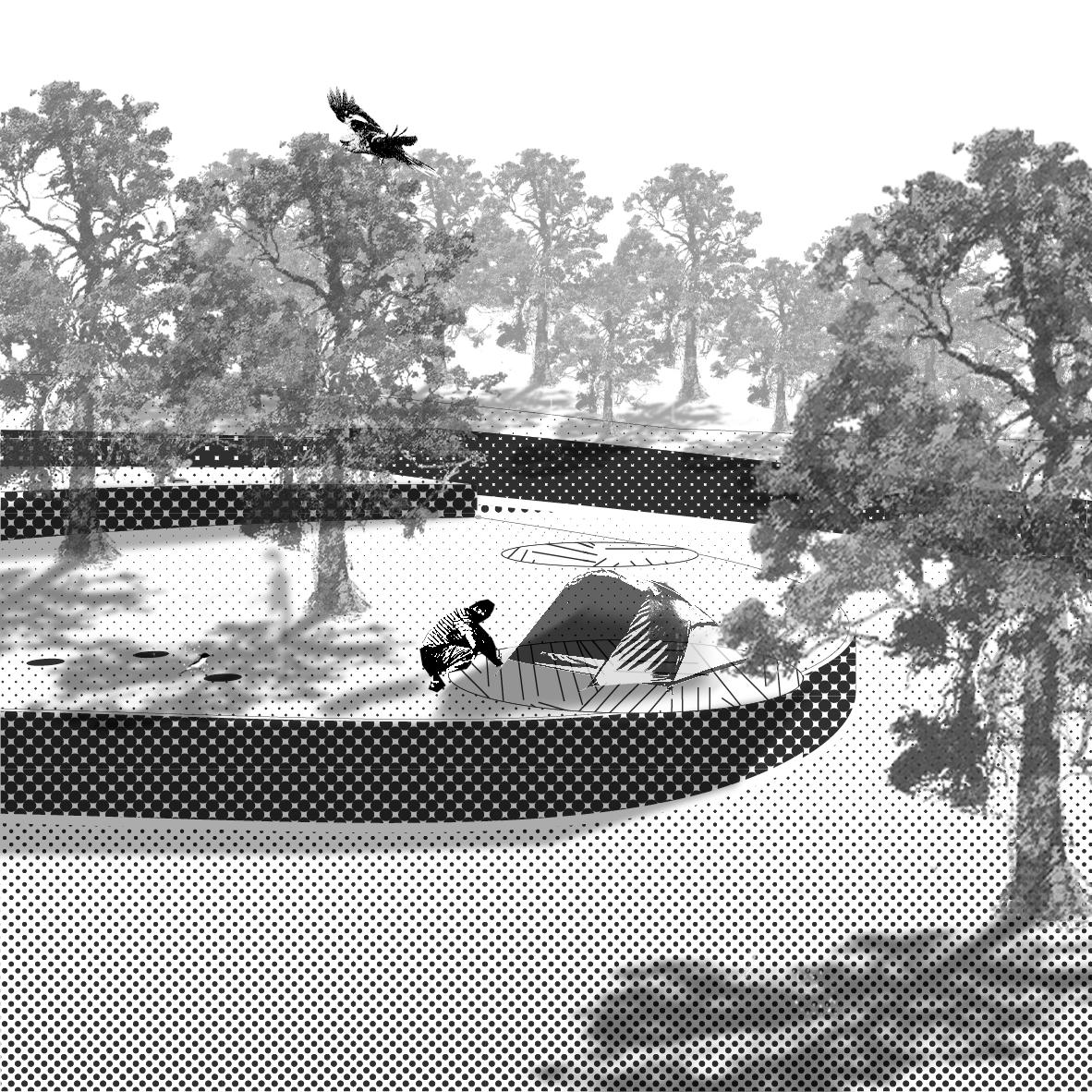

A lookout that collects water and stores it for the walkers to use at the top of Mt Napier



Acacia Melanoxylon is grown around the outer edges to reflect thow Acacia would have growinn around the edges of the crater 30,000 years ago where a lake would have been - creating an abundance of life from the rich basalt from the explosion.



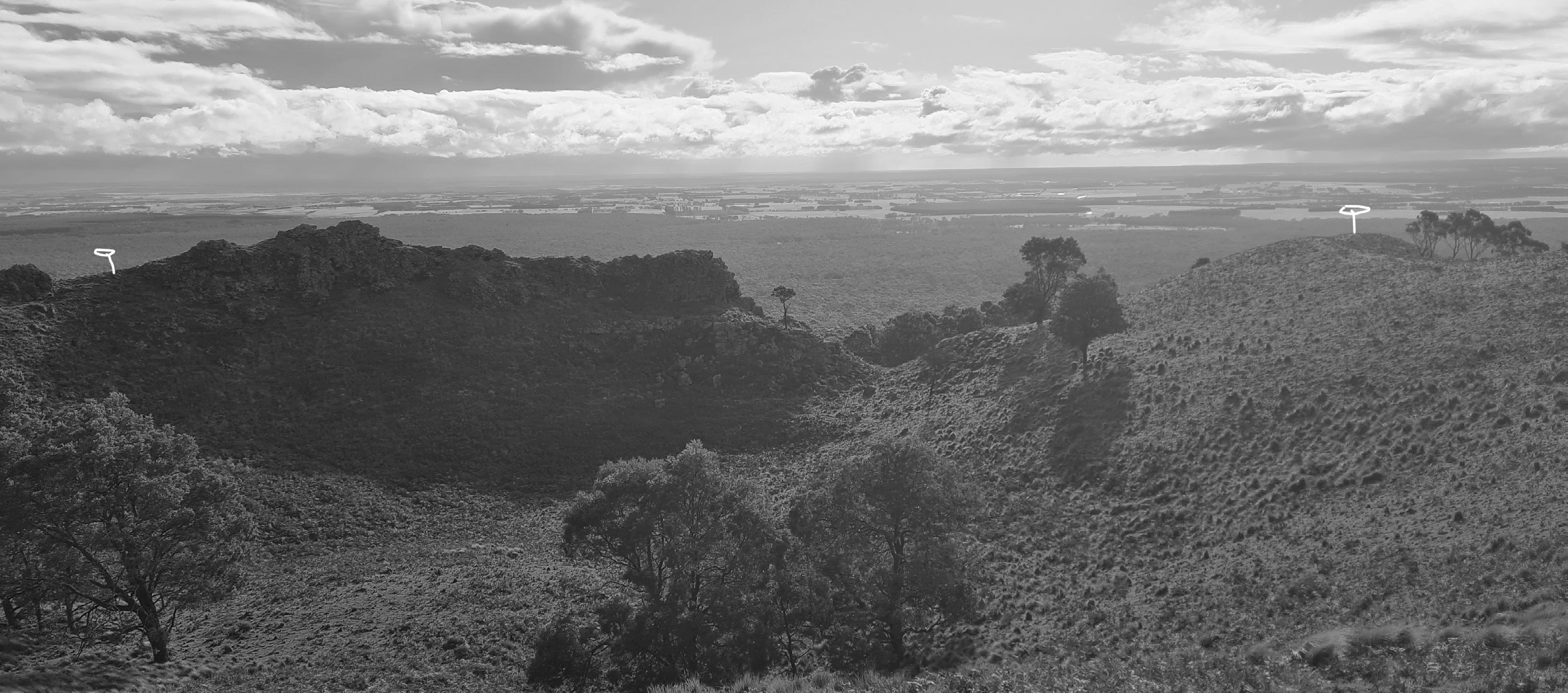




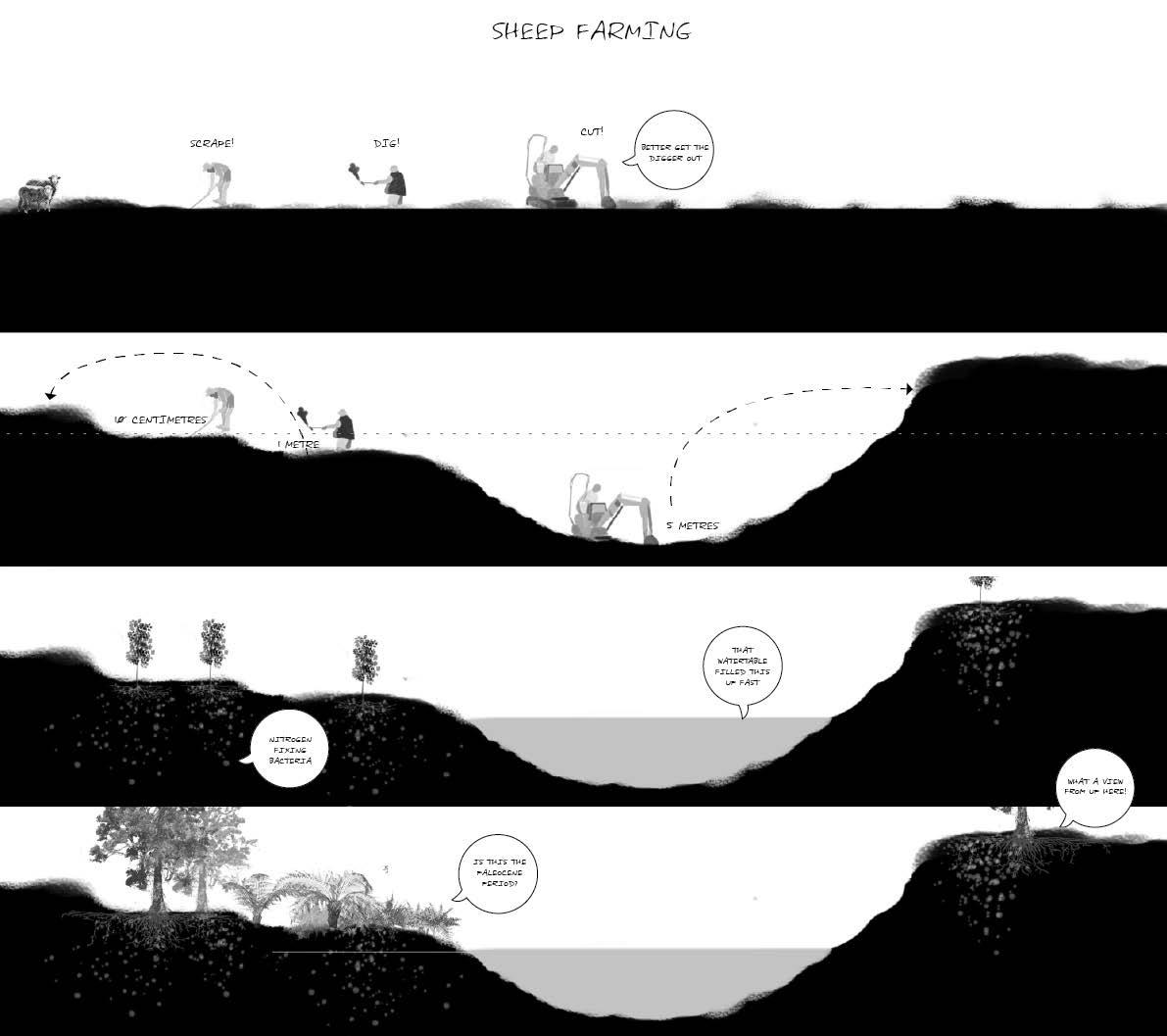
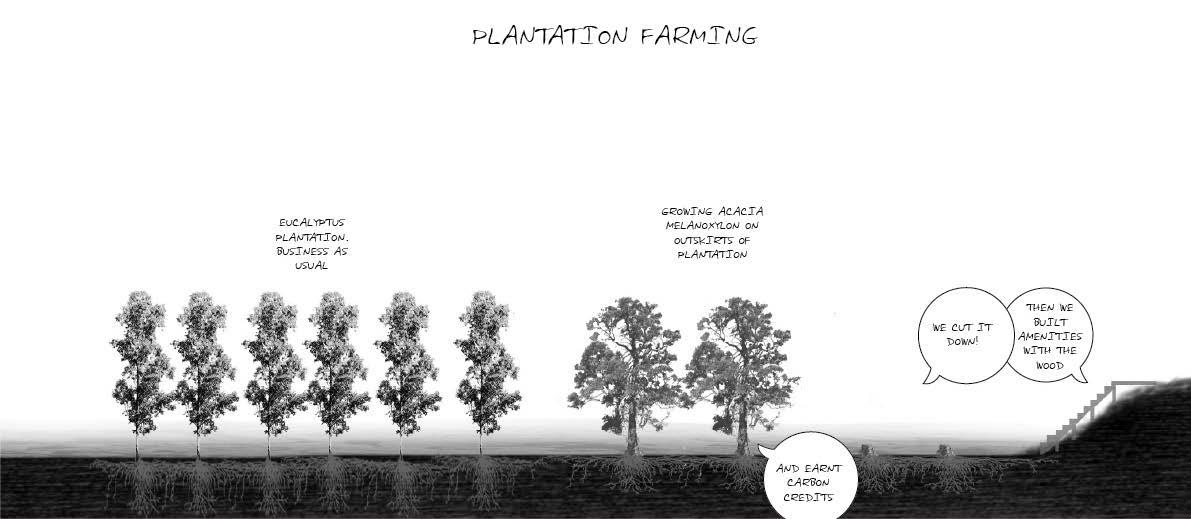
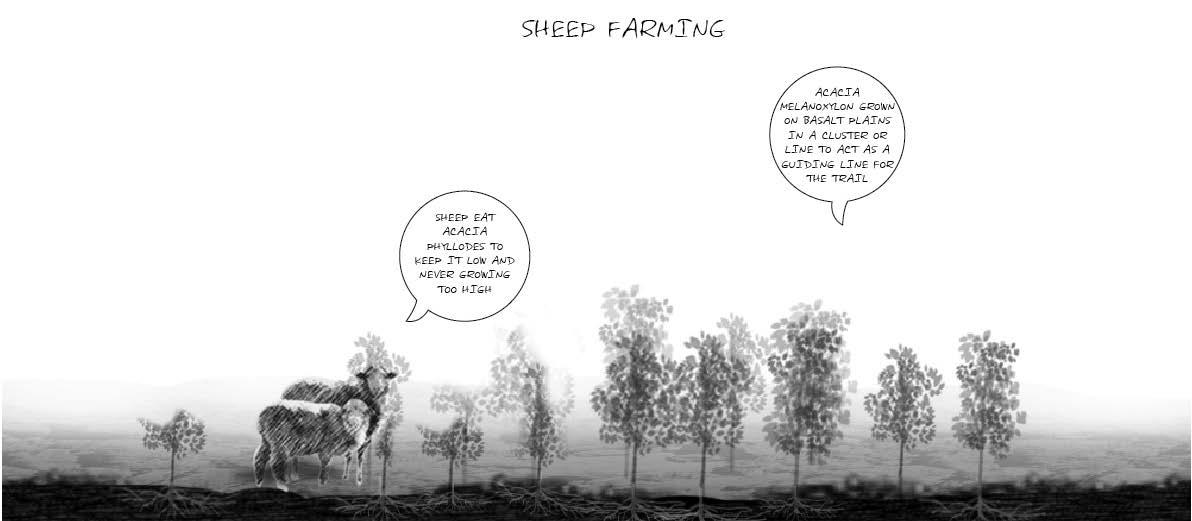


“ Eruption was not confined to a single crater, as small perfectly parisitic cone, with craters, ddeveloped on the northern and western slopes of the main cone. Other small eruptive points associated with the main Mt. Napuer cone are scoria domes, whch lack a crater. Mt Napier is surrounded by individual lobes of lava which have combined to form a broad area called the Napier lava plataeu” (King. R. 1978/99)
“molten basalt is drained beneath a partially solidified skin, caves may result as in the ccase of the lava flow from Mt. Napier that infilled Harman’s valley... the caves are aligned along the centre of the flow with a few branches” (King. R. 1978/99)
When molten magma pierces the earth’s surface, it cools rapidly. Quenched bythe cool air or the ocean’s water, it quickly hardens into glassy or fi ne-grainedrocks like obsidian or basalt. But when magma is contained by overlying rockand pressured from below, it cools more slowly. In the cooling process, the elements in the magma have time to crystalize, grow, and co-mingle as distinctmineral grains. This slow organization and cooling under pressure makes the coarse-grained rock that we recognize as “granite.” (Hutton, J 2019)
“The Eccles lava flow would, through the disruption of the preexisting drainage, have rapidly created resource-rich aquatic environments around the flow”
“The peak in pollen concentration above the date of 25 000 cal. yr BP”
After the flow of lava: “fresh water was clearly present on the lava flow from shortly after the time of its formation, as indicated by basal dates at Tyrendarra, this landscape may have been unsuitable for occupation for many thousands of years...Low pollen concentrations suggest that the basalt surfaces were largely devoid of vegetation.”
Algal ooze to peat in the water systems after the Volcanic spread “Subsequent aquatic succession was marked by a switch from algal ooze to peat incorporating a number of plants, including Typha, Eleocharis and, eventually, Triglochin that could have been exploited”
“establishment of widespread freshwater swamp and lake environments on and around the lava flow by at least 13 000–12 000 years ago” - the development of trees possibly The lack of indigenous management around the time of european settlement would be a decrease in burnings, and therefore less germination of Acacia Melanoxylon “This pattern of reduced and more variable effective moisture, associated with an increase in burning, is consistent with that from the western plains generally,”
“change in pollen and diatoms came into phase around 3750 years ago for the first time within the Lake Surprise record, human impact could also have come into the equation.”3750 years ago the pollen changed significantly (european settlement
Quartenary period(2Ma): megafauna for 90,000 years. and first nations have been here fsince 60,000 years ago. (Australian Museum, Mar 22)
Tertiary period(66Ma): plants similar to what we have today. warm climate at the beginning favoured dense forests. towards the end - more grasslands support grazing animals. Birds feature heavily in tertiary, developed before mammals. Trout and bass evolved
Cretacious (145Ma): Dinosaurs (with rivers ) and flowering plants evolved. Many trees ancestors came from this period as plants with cones
Jurassic: (201 Ma) Dinosaurs + volcanos along sea floor
Permian - (296Ma) glacial
Devonian - (419Ma) Fish and ferns
PALEOZOICSilurian (441Ma) Sea scorpians 10ft long + moss near wateredge. Marine + fluvial
Ordovician (485Ma) - underwater + algae near edges. mostly granite
Cambrian (541Ma) - explosion of life

Geological sketches of the site that helped me figure out how the site was formed. This was quite tricky and was the steepest learning curve for me in this studio.



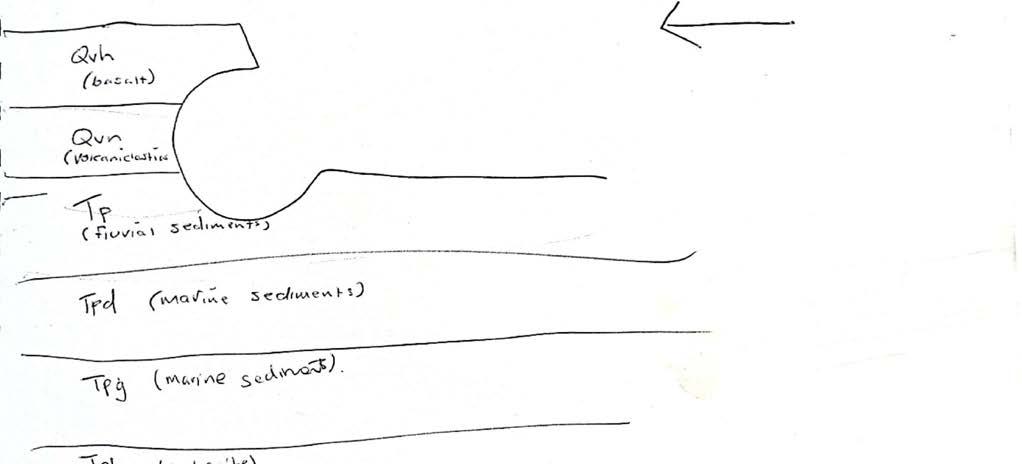
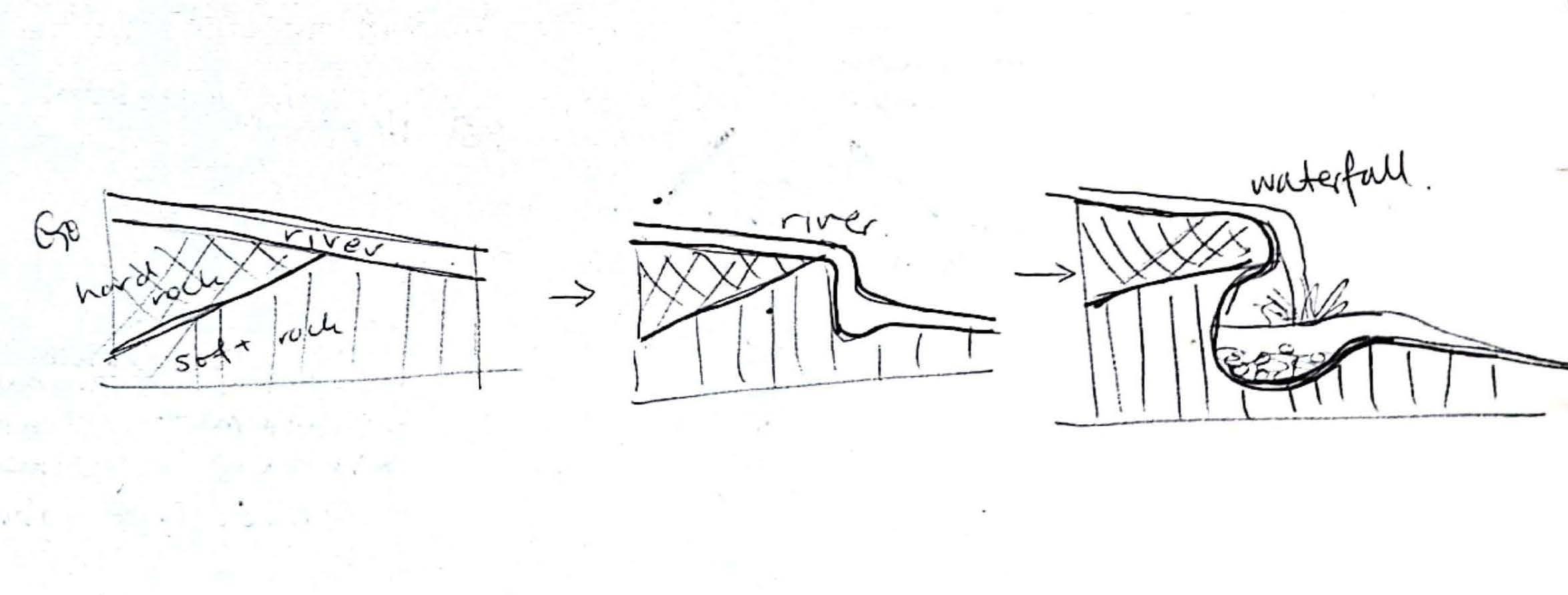

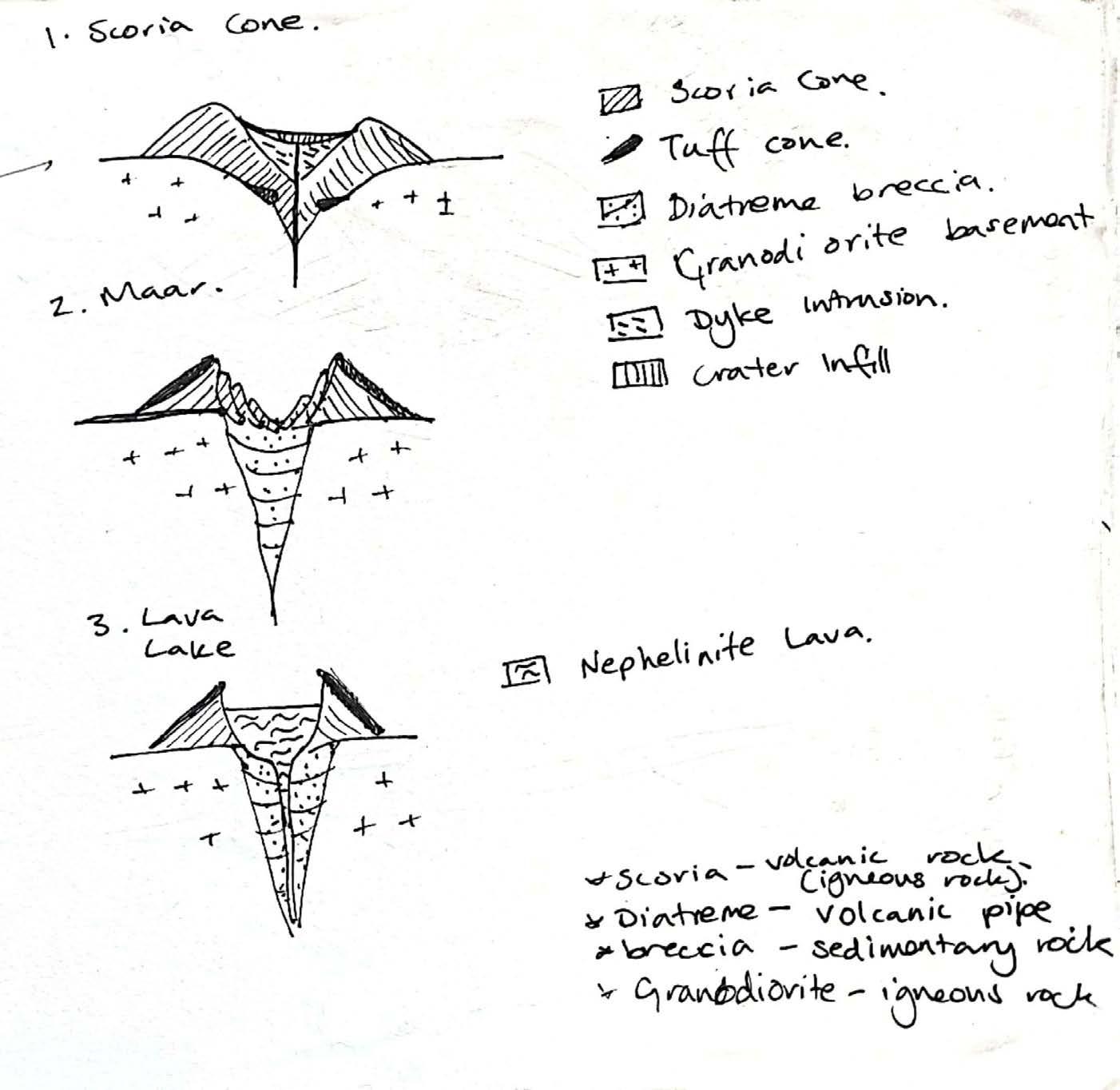



Decorative timber - cabinets, musical instruments, boatbuilding
First Nations use: Used to make spear-throwers, boomerangs, clubs and shields. Soaked the bark in water to bathe painful joints (make an analgesic. The inner bark was used to make string.
first nations: leaves as a natural soap by rubbing hands togeter with a bit of water and leaves. thick sap used as an adhesive to join pieces of blackwood to craft weapons. (Murphy, S 2020)
Forestry plantations in eastern africa (ncl. Kenya and ethopia), south africa and zimbabwe - for lumber, fuelwood, amenity plantings. Wood is turned into tool handles, light construction, turnery, fence posts.
Used as a nurse tree to rehabilitate disturbed natural forests
“It is described as one of the world’s finest furniture timbers.” - (Murphy, S. 2020)
usually at higher altitudes, cheifly in sclerophyll forest and in or near cooler rainforest
South Africa: noxious weed Portugals Azore’s islands : pest
Tanzania: An invasive species introduced before the first world war
Next to rivers: Acacia Dealbata and Acacia melanoxylon often share a river bank, growing on the river flat and providing the understorey to a canopy of river red gums (Murphy, S, 2020)
“very wide distribution from northern Queensland right down the east coast to Tasmania. It also occurs naturally in the Mt Lofty region of SA.” (Murphy, S. 2020)
Seeds after fire or basal suckering (root suckers) particularly when the roots are damaged, Root suckers travel quite a big distance laterally
and enable clumping / density of acacia from a single plant
Pioneer species are hardy species which are the first to colonize barren environments
Seedlings intolerant to shade
Seeds often hang off tree for months - as if “advertising availability” (Murphy, S 2020)
Seed spread by animals, particuarly birds. Also spread by dumped garden waste and contaminated soil.
Pods (with seeds) can float on water
borers, scale, galls, leaf miners
Prefres higher moisture content “due to a higher decomposition rate of organic matter and parent rock material. A reduction in nutrient concentrations could therefore be a potential effect of global warming on soil chemical properties”. e.g. Ammonium-N is preferred nitrogen intake of Acacia Melanoxylon. It is a good indicator soil organic matter (i.e. soil structure, water retention). If Ammonium-N concentrations decreases , acacia’s will decrease - (Martin. R 2009)
“Its best suited to moist soils and damp gullies.” - (Murphy, S 2020)

“hosts nitrogen-fixing Rhizobium bacteria (like all wattles) that improve soil fertility” - (Murphy, S 2020)
since 1997, shifts in rainfall and temperature, with hot northerly summer winds, cause soil to dry out and less organic matter to decompose, then leads to water stress and canopy dieback of trees. “global warming will cause landscapelevel tree decline and mortality through prolonged cycles of water stress.” (Martin. R 2009)
“Its dense foliage also provides shelter for many birds” - (Murphy, S 2020) (Murphy, S 2020)
Mt Napier regional Park:
Sulphur crested cockatoo, crimson rosella, red wattlebird, yellow faced honeyeater, white-naped honeyeater eat te seeds
Grey Fantail (Rhipidura albiscapa) and Superb Fairywren (Malurus cyaneus) gather insects from Blackwood leaves
“Ants harvest seeds for the oil rich aril and take the seeds underground where they will remain viable for centuries”
Silvereye (Zosterops lateralis) , Yellow-faced Honeyeater (Caligavis chrysops), White-throated Treecreeper (Cormobates leucophaea), Eastern Spinebill (Acanthorhynchus tenuirostris) are enticed by the sugary sap that is produced at the base of the phyllodes during flowering - helping with pollination
Sugar Glider (Petaurus breviceps) wound the tree to bleed it and feed on the protein-rich sap (Murphy, S 2020)(Bird. P. R, 1997)
“Reciprocal Landscapes: Stories of Material Movements examines how the construction of a landscape in one place is related to transformation elsewhere.”
“By tugging on one seemingly thin thread, two sites are pulled together and a tangle of relations appears: how a particular geological or ecological condition became a desirable material commodity, how a material came to travel a certain route to the construction site, how the two sites (and the people and other species that occupy them) fared in this material transaction, and finally, how design and aesthetics participate in all of this.”
“to think of construction materials as continuous with the landscapes they come from, and with the people that shape them”
To “attempt to see” the relationships of materials, Hutton looks at “first, tracing a materials movements”...;”comparing site of materilal production and consumption”...and...”examing how these larger materials relations play out in the designs” precedent: “the project Who Builds Your Architecture? (WBYA?) asks architects to address the working conditions of people constructing the buildings they design.”
The connection between the landscape and the human made world is not reciprocal, but one of inequality. By the time the material has been used for human-scale, the landscape and the people that harvest it are often exploited and at a loss. Finding the whole story of the living/non-living is crucial.
The process of moving landscape to forming it to construction material to product detaches the material from the landscape so far, that we forget the wide reaching effect of everything we use.

“A “motion,” in late-nineteenth-century quarrying terminology, is the work area drawn by the rotation of a quarry derrick, but it is also a specifi c type of small quarry where paving blocks
are cut directly from the ground.” (Hutton, J 2019)
““material flow” conjures flowcharts...indicating the unidirectional movement of abstract material streams between extraction and use sites”...”tend to conceal the role of human labor” (Hutton, J 2019)
- The ‘material flow’ is a linear concept. Material are not linear. They are cycled repeatedly. The use of the material in the economic sense creates an ‘end’ and a ‘start’ with a blinding to what was the original material.
“While some geologists might ponder the formative processes of rock, architects consider durability in terms of structure and cultural taste. While some might examine the surrounding landscape to understand intrusion, others examine it to locate and estimate financial returns in relation to transport and market.”
“many aspects of geological interest translated directly into issues of economic importance and architectural applications.”
We all look at materials differently. Some see it as a scientific display of the earth's processes, some see it as providing structure and cultural taste to buildings, some understand intrusions by looking at what’s around it and some see financial return.
““Where Granite Went.” In it, page after page of photos, newspaper clippings, and bills of sale record the trajectories of paving blocks, building blocks, and carved stone from Vinalhaven. Like a scrapbook of milestones and journeys of a human lifetime”
I have created a 'scrapbook' of a story of the history and the future of granite as it moves through time and space. The further exploration of this would be to look at the waste of the material as it moves through the ‘economic and social’ uses. What is left at the end? Processes always create waste. These waste piles are given a life of their own.
“speculative fiction can make public the climate crisis” “the systems of representation through which society has related to complex environmental issues among their various actors and in the vast scales of time and space.”
“Of Oil and Ice,” a geostory, casts an iceberg as a planetary protagonist and relates its trajectory as it migrates from the Antarctic ice shelf to a glass of water in the Persian Gulf” - the creation of a story
“Anthropocene”
- the period of time from when humans started to have an impact on the climate
“Icebergs..fantastic shapes exhausted the descriptive vocabulary of the sublime with paintings such as The Iceberg (1861).”
- Are there any painting about the acacia melanoxylon?
“In the organic world, for instance, soft tissue ... reigned supreme until 500million years ago. At that point, some of the conglomerations of fleshy matter-energy that made up life under went a suddent mineralization...:bone” (De Landa, M 1997)
“the meeting points of rich merchants from all over Europe, were veritable hierarchies of meshworks, in which the luxury and money markets dominated the upper echelons.” (De Landa, M 1997)
In De Landa’s writings, there are hierarchies of trade and capitalism. These create a layers. This relates to the hierarchy of the layers of the earth. That which is underneath- the parts you cant see - are the driving forces of the minerals of the area, keeping the flora alive.
the layers of microcosms are laid out on the geological beds underneath Wannon Falls, Byaduk caves and Mt Napier in fossilised form and the hint of what might have been
“ Instead, I offer stories built through layered and disparate practices of knowing and being. If the components clash with each other, this only enlarges what such stories can do” (Tsign, A. L. 2017)
“Disturbance is a change in environmental conditions that causes a pronounced change in an ecosystem. Floods and fires are forms of disturbance; humans and other living things can also cause disturbance. Disturbance can renew ecologies as well as destroy them. How terrible a disturbance is depends on many things, including scale. Some disturbances are small: a tree falls in the forest, creating a light gap. Some are huge: a tsunami knocks open a nuclear power plant. Scales of time also matter: short- term damage may be followed by exuberant regrowth. Disturbance opens the terrain for transformative encounters, making new landscape assemblages possible” (Tsign, A. L. 2017)
“disturbance is always in the middle of things: the term does not refer us to a harmonious state before disturbance. Disturbances follow other disturbances. Thus all landscapes are disturbed; disturbance is ordinary” (Tsign, A. L. 2017)
Deciding what counts as disturbance is always a matter of point of view. From a human’s vantage, the disturbance that destroys an anthill is vastly different from that obliterating a human city. From an ant’s perspective, the stakes are different. Points of view also vary within species” (Tsign, A. L. 2017)
“Disturbance brings us into heterogeneity, a key lens for landscapes. Disturbance creates patches, each shaped by diverse conjunctures.”

- disturbance is the ordinary - the scale of which depends on the world it creates
- millions of individual worlds not just across species, but within species as each thing experiences different disturbances
- there is a story to every living thing - flora, fauna, fungi. The story of survival, of spreading, travelling and thriving in different envrionments.
“By “culture”, I refer to... a dynamic entity constructed from the vocabularies, attitudes, customs, neliefs, social foms, and material characteristics of a particular society” - the creation of a society and culture
“I argue that ecology, creativity, and landscape architecture must be considered in terms other or greater than those of visual appearance, resource value, habitat structure, or instrumentality.
Instead,...might be complemented by an understanding of how ecology, creativity, and landsacpe architecture are metaphorical and idealogical representations”
“Significant here is how ecology and landscpae architectural design might invent alternative forms of realtionship between people, place, and cosmos. Thus the landscape architecture practice becomes more about the invention of new forms and programs than the merely corrective measures of restoration.”
Ecology is “the combination of many processes flowing at the same time along various scales, leading ... to a symphony at some tmes harsh and at some times pleasing.”
An aquarium, he asserted, was “the perfect way to get acquainted with the peculiar creature of the ocean without having to descend into the depths.”(Ghosn. E; Jazairy. E. H. 2017)
“I want to insist that the re-enchantment of nature ... be mobilized against establishment environmentalism. —Neil Smith1” (Ghosn. E; Jazairy. E. H. 2017)
“. Here, “scientific, socioeconomic, technological and political forces were manifested, entailing new modes and aesthetics for the production of evidence.”6 It is both an aquatic cabinet of curiosities... by framing a portion of the underwater world gestures toward an unframable whole” (Ghosn. E; Jazairy. E. H. 2017)
“the microcosm... aspires to build a world beyond the strict values of the economy” “ “The reduction in scale which the miniature presents skews the time and space relations of the everyday lifeworld, and as an object consumed the miniature finds its ‘use value’ transformed into the infinite time of reverie”12.
“. A series of nine aquariums, each addressing a particular economy-environment nexus, reclaim ocean space into public controversies by connecting political ecology with speculative design”
“1. The aquarium is three-dimensional territory”
“2. The aquarium is populated”
“3. The aquarium is now. Rather than the...Anthropocene representations of exponential...disaster satellite images, the aquarium facors an immersive, enchanting experience. The aquarium slows down thought”
“4. The aquarium is also there”...”With monsters, storms, a modern day Noah, scientists and jellyfish on stage, the aquarium is the setting in which the nonspeaking and nonhum entities operate as devices of engagement”
“5. The aquarium holds vividsly in tension the panorama and its details. It stages a slice of the ocean nesting a range of scalefrom the micro the macro” (Ghosn. E; Jazairy. E. H. 2017)
Anon., (2004) ‘Review of Symzonia: A Voyage of Discovery’ in The Literary Gazette; or, Journal of Criticism, Science and the Arts. 6 January 1821 (Vol. 1, No. 1), p.8
Australian Museum (2022). Megafauna. https:// australian.museum/learn/australia-over-time/ megafauna/ [accessed on 3 Aug 2022]
Australian National Botanic Garderns;Australian National Biodiversity Research Canberra (2015). Acacia Melanoxylon. https://www.anbg.gov.au/ aborig.s.e.aust/acacia-melanoxylon.html [accessed on 1st Aug 2022]
Beer, D. (2021). Creating the Rainforest Gully at the Australian National Botanic Gardens. Australian Garden History, vol. 32, no. 4.
BioNET-INTERNATIONAL (n.d.) FactsheetAcacia Melanoxylon (Australian Blackwood). https:// keys.lucidcentral.org/keys/v3/eafrinet/weeds/ key/weeds/Media/Html/Acacia_melanoxylon_ (Australian_Blackwood).htm [Access on 21 July 2022]
Bird P.R. (1997) Mammals and Birds of the Mount Napier State Park. Report to Hamilton Field Naturalists Club Victoria. https://www.hamiltonfield-naturalists-club-victoria.org.au/images/pdf/ FaunaReports/Mammals/Mammals-&-Birds-of-MtNapier-State-Park-1997.pdf [accessed 3 Aug 2022]
Bourke, J. (2017) Forged by Fire: Volcanoes in Victoria. Retrieved 22 July 2022, from https:// www.australiangeographic.com.au/topics/scienceenvironment/2017/05/volcanic-victoria/
Builth, H., Kershaw, A. P., White, C., Roach, A., Hartney, L., McKenzie, M., Lewis, T., & Jacobsen, G. (2008). Environmental and cultural change on the Mt Eccles lava-flow landscapes of southwest Victoria, Australia. The Holocene, 18(3), 413–424. https://doi. org/10.1177/0959683607087931
EBird (n.d.) Mount Napier State Park. https://ebird.
org/hotspot/L2531654?yr=all&m=&rank=hc&hs_ sortBy=count&hs_o=desc [accessed 3 Aug 2022]
Exploring the Earth (2022). Active volcanoes in Victoria, Australia. Retrieved 22 July 2022, from http://exploringtheearth.com/2015/01/06/ volcanovictoria/
Hester Blum (2012). ‘John Cleves Symmes and the Planetary Reach of Polar Exploration’, American Literature (Vol. 84, No. 2, June 2012), p. 261.
Howes, J (29th Jan 2021) Acacia Melanoxylon, Blackwood, HIckory, Mudgerabah, Tasmanian Blackwood, Blackwood Acacia
King. R. (1978/99) Geology of the Mount NapierByaduk area. [Unpublished Report]
Mann, C. Mann D (n.d.). Geologic Time Eras. https://www.fossils-facts-and-finds.com/geologictime.html [accessed 3 Aug 2022]
Martin, R. (2009). Linking climate induced water deficit with canopy dieback on a forested scoria cone in Victoria’s basalt plain. Report to Parks Victoria, Southern Goldfields Region. School of Science and Engineering, University of Ballarat, Mt Helen.
Murphy, S (2020). Blackwood - Connecting with nature one plant at a time - going wild in isolation. https://www.recreatingthecountry.com.au/blog/ blackwood-connecting-with-nature-one-plant-at-atime-going-wild-in-isolation [accessed on 3rd Aug 2022]
Peter Fitting. (2004). Subterranean Worlds. P. 106. Wesleyan University Press.
PlantNET (The NSW Plant Information Network System). (2012) Royal Botanic Gardens and Domain Trust, Sydney..https://plantnet.rbgsyd.nsw.gov.au [Accessed on 1 Aug 2022]
Tsing, A. L. (2017). The mushroom at the end of the world (ch.11). Princeton University Press.
Ware. C (2014) Chris Ware on Here by Richard Mcguire - a game changing graphic novelv
Wrigley, J; Fagg, M. Starting Out with Natives. Easy to Grow Plants in Your Area. Reed New Holland Publishers, 2002.
Garten + Landschaft. (2019). With Different Eyes - Giorna Shores. https://lapinyabarcelona.com/blogarchive/girona-shores
French, M. (2022). Lecture: Girona Shores. RMIT University.
Eastern Maar Aboriginal Corporation. (2015). Meerreengeeye Ngakeepoorryeeyt. www.emac.com.au
Koch, P.J. and Wong, N. (2015). A collaborative landscape conservation plan for the Victorian Volcanic Plain. Summary report. Greening Australia and Trust for Nature.
Mostyn, G. (2005). Management Plan for Wannon Falls Scenic Reserve and Nigretta Falls Scenic Reserve. Southern Grampians Shire Council.
De Landa, Manuel. (1997). A thousand years of nonlinear history. New York : Zone Books
Corner, J. (1997) Ecology and Landscape as Agents of Creativity. In G. F. Thompson & F. R. Steiner (Eds.) Ecological Design and Planning (pp 81-106)
Hutton, J (2019) Reciprocal Landscapes : Stories of Material Movements (Intro, Ch. 2). Taylor & Francis Group

Joergensen, A (2016) Drawing Futures (p.96-99 ch. Drawing a Volcanarium, or How to Represent a Very Large Figure) from https://www.uclpress.co.uk/ products/83097v
Rania Ghosn (2020) A Flooded Thirsty World, Journal of Architectural Education, 74:1, 60-69,
Seaborn. A (1820) Symzonia; A Voyage of Discovery. J Seymour, New York. Accessed from https:// www.gutenberg.org/files/54485/54485-h/54485-h. htm#ch5
Parks Victoria. (2015). Ngootyoong Gunditj Ngootyoong Mar South West Management Plan.
Winda-Mara Aboriginal Corporation. (n.d.) Koorelah Plan of Management 2021-25.

